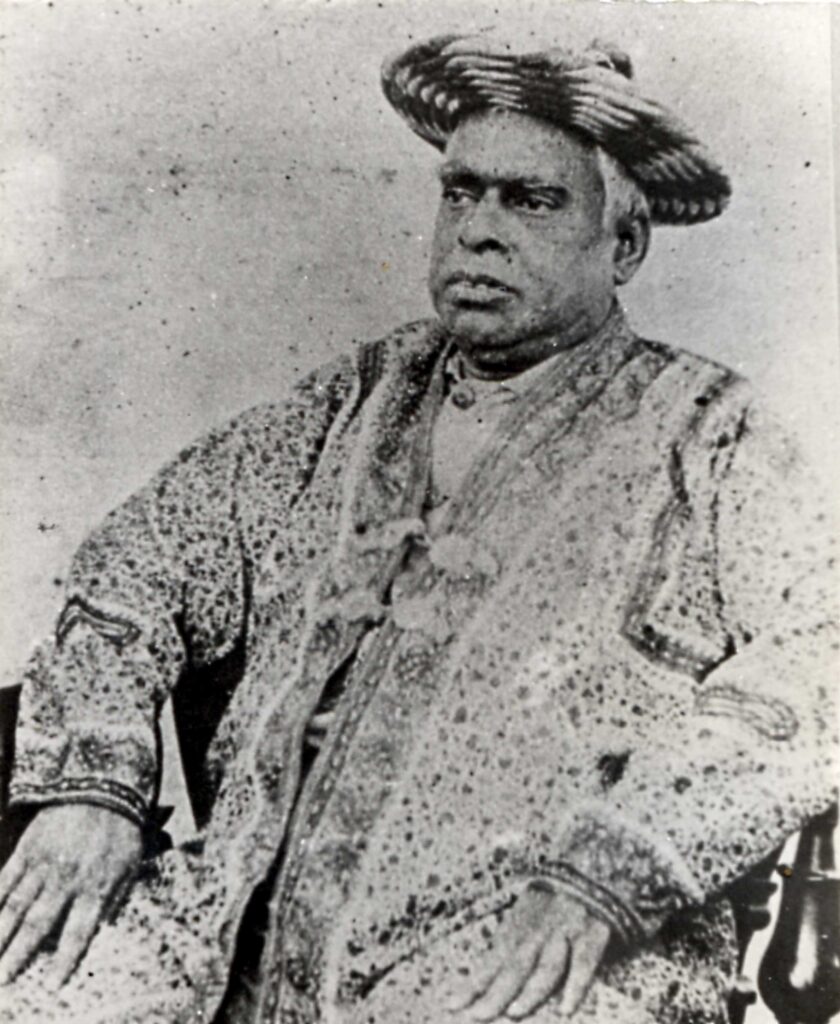
Retirement and Expansion of Preaching
In mid-1893 the Thakura was requested to resume his duties by Sir Henry Cotton, Chief Secretary to the Government of Bengal. Srlla Bhaktivinoda wanted to resume his service in Krishnanagar, but he was asked to go to Sasaram where there were riots between Hindus and Moslems. He recalls:
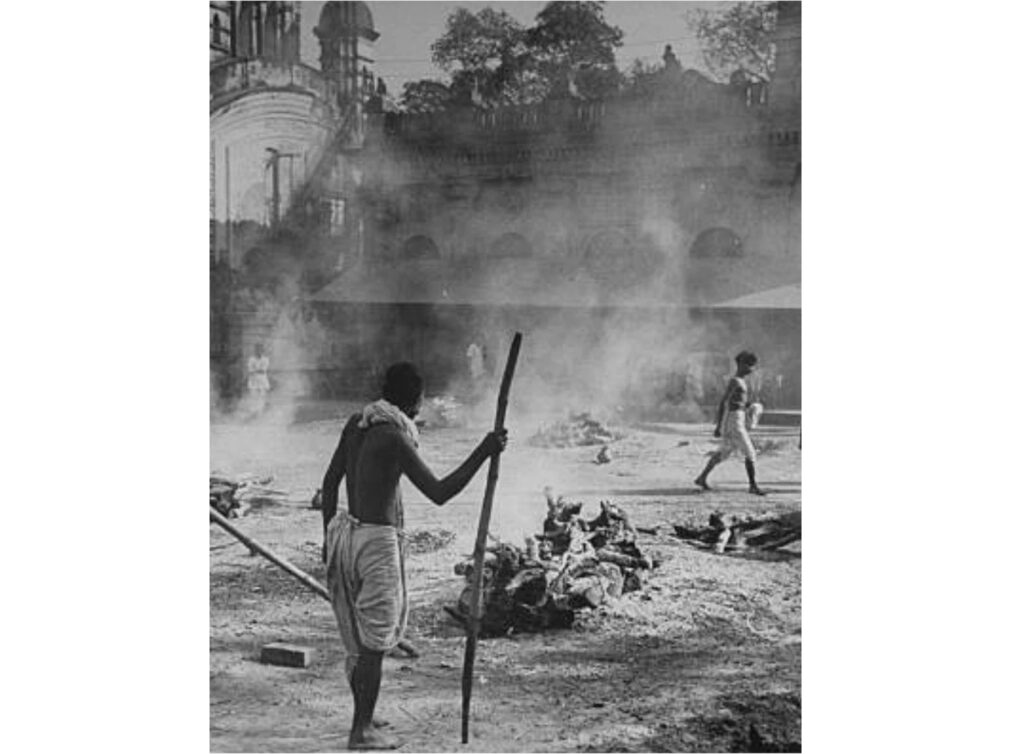
… there was a serious dispute between the Hindus and Moslems over cow slaughter. There had been very good relations between the Hindus and Moslems for many a year, but because of cow slaughter their good relations had ended. The feelings of hostility were mutual and there was constant fighting between them. In the town of Sasaram there were many alleys and lanes, and Moslems and Hindus lived cheek by jowl. Because of this there was plenty of opportunity for disputes. Fighting would develop daily. A certain Vaisnava sannyasi bought a small piece of land facing my court office, and he endeavoured to build a temple there. The Moslems insisted that the temple could not be built. The sannyasi spoke to me about the matter, and I spoke to the Moslem Serestadara so as to know the thoughts of the local Moslems on this matter.
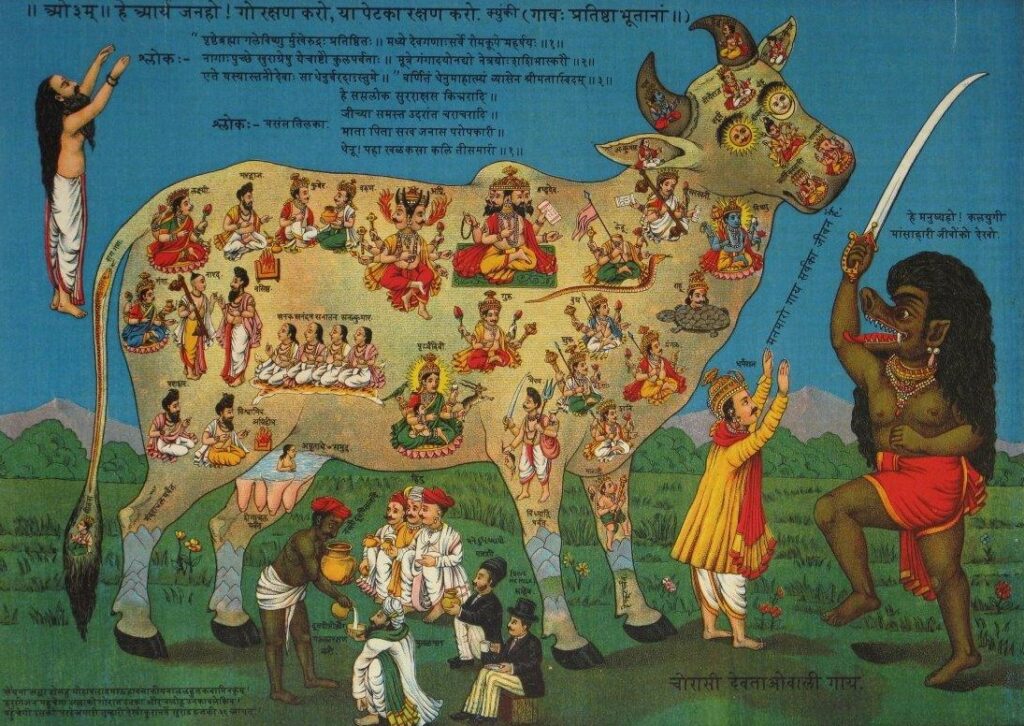
Cow Protection Poster from 1890s
The sannyasi did not wait for the result [of the talks], and he began to build the temple [anyway]. That particular day I was in Nasariganga. Moslems went [to the plot of land] with sticks and swords to fight. The leaders among the Moslems sent a telegram to the government, and the Commissioner was informed that the sannyasi was building the temple over a [Moslem] tomb and that it was being done with the connivance of Hindu officers. Many letters were exchanged concerning this matter. Being a Hindu officer it was difficult for me to stay in Sasaram [and remain impartial]. I made many attempts to get away from Sasaram. My superior officers gave much help to me, and the government secretaries informed me that there would be a transfer elsewhere at a suitable time.
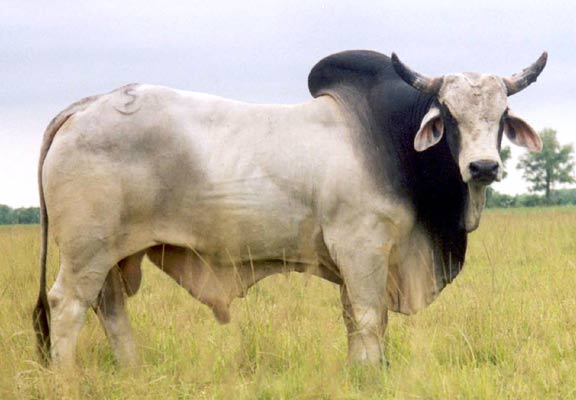
In the meantime the Thakura was requested to go to Koyath as a matter of urgency, with a similar dispute over a prized bull, the property of a brahmana, which disappeared while he was away. This also led to riots between Mosles and Hindus. The Thakur describes the difficulty of dealing with such cases:
By the afternoon the Moslem group had grown, and taking up guns and swords, some of them injured some Hindus. The injured persons had to be sent to hospital. After some delay the police came, but they were not able to do anything. Finally, they saw the Moslems creating a disturbance, but because the fight was not started by the Moslems, but, rather, was started by the Hindus, the Hindus were considered to be at fault …
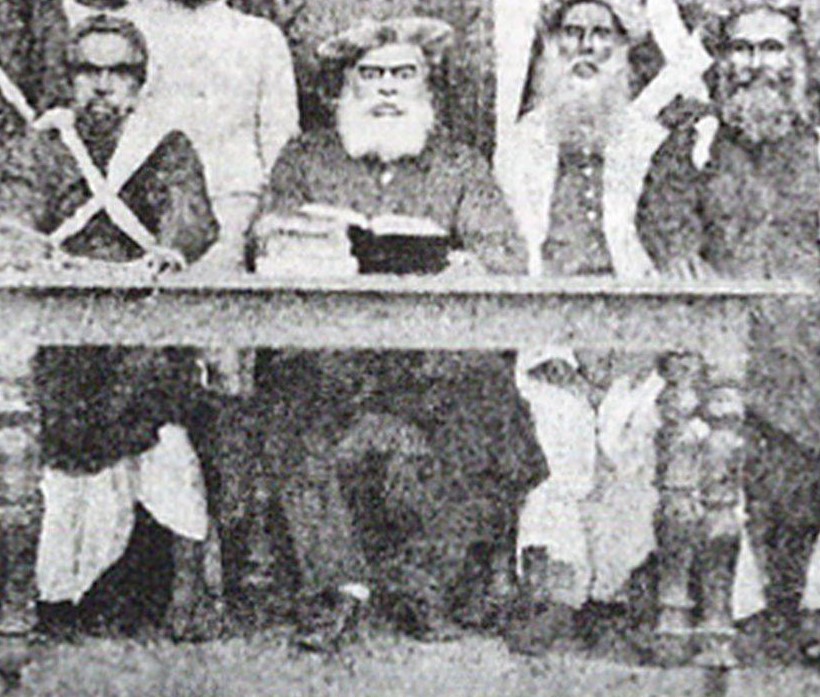
After carefully questioning witnesses from both sides I gave two-year prison sentences to a few Hindu men. Then, after examining the witnesses against the Moslems, I gave two-year prison sentences to some of them. They appealed to the high court against my decision in these two trials, but my decision was upheld.
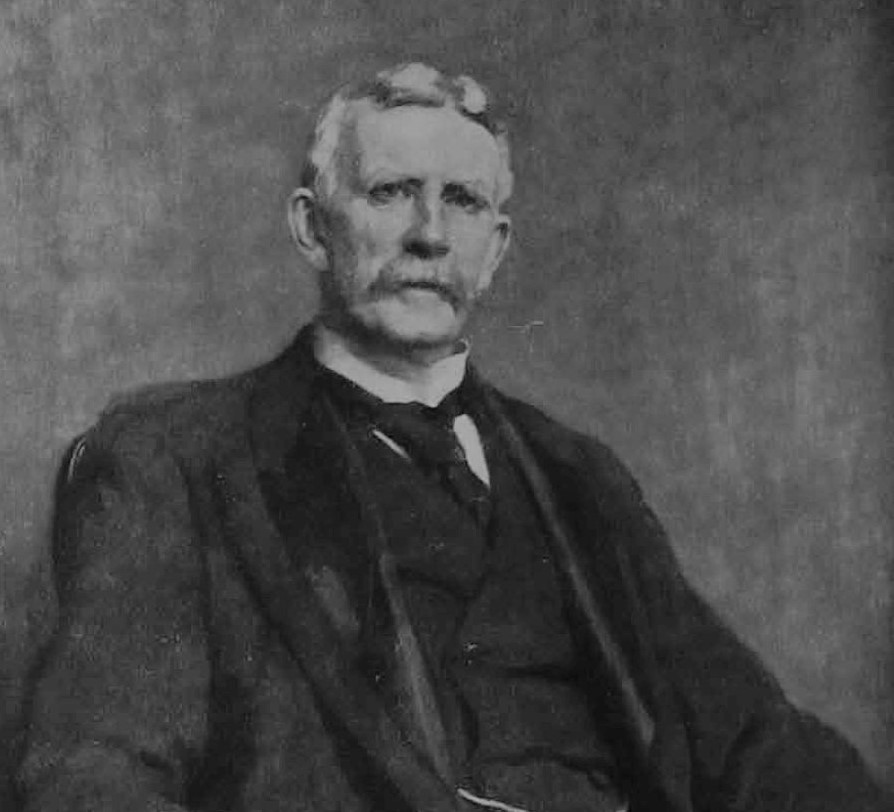
Sir Henry Cotton
Finally, the Thakur wrote to Sir Henry Cotton and he received a transfer to Nadia. He comments:
The days of my trouble were over. In the month of October I came to Calcutta from Sasaram.
The Thakur’s work-load was somewhat reduced, and he again contemplated his retirement longingly. The year was 1894. In Krishnanagar a grand meeting of the Sri Navadvipa-dhama-pracarini-sabha was held and many scholarly men attended. After much discussion it was decided that Deities must be established at the Yogapitha (birth site of Lord Gauranga). In October of 1894, at the age of fifty-six, the Thakura decided to retire from government service against the protestations of government authorities and some of his family members. He felt that the greater work of preaching the glories of the Holy Name was urgent and that his government service was a hindrance. He retired to Surabhi-kunja in Godrumadvipa, where he engaged himself fully in preaching, chanting and writing. He revised many of his previous writings, perfecting and refining them. No longer was he distracted by mundane duties.
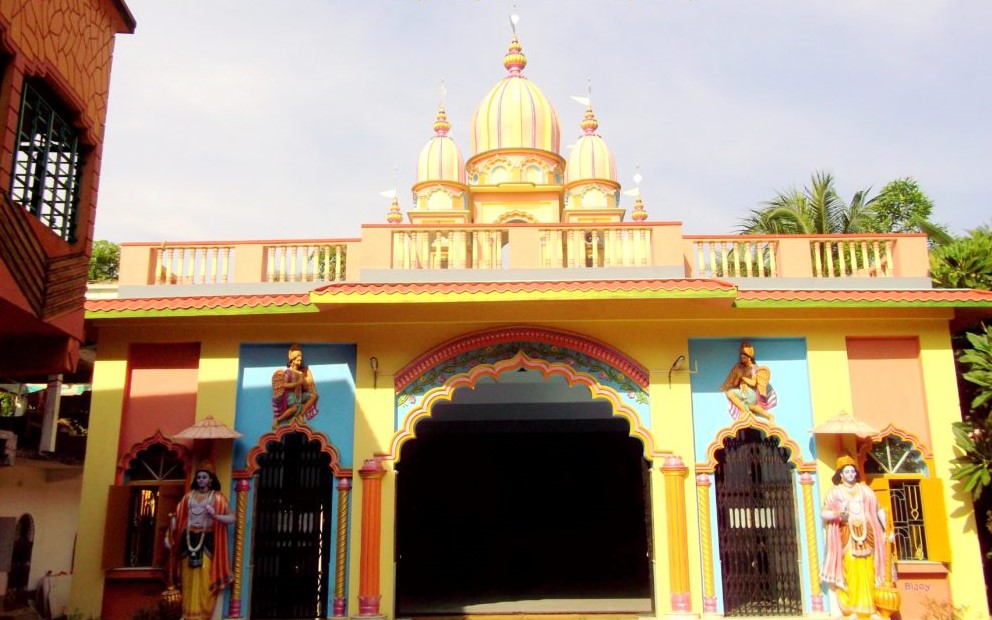
Site of Srila Bhaktivinoda Thakur’s residence in Godrumadvipa, Surabhi Kunja
On December 6, 1894, an article appeared in the Amrta Bazar Patrika (newspaper) that describes how, just after the Thakur’s retirement from government service, he began going from door to door in Calcutta, begging donations for Lord Chaitanya’s Temple in Mayapur in a spirit of perfect humility:
Babu Kedar Nath Dutt, the distinguished Deputy Magistrate, who has just retired from the service, is one of the most active members. Indeed, Babu Kedar Nath has been deputed by the committee to raise subscription in Calcutta and elsewhere and is determined to go from house to house, if necessary, and beg a rupee from each Hindu gentleman for the noble purpose. If Babu Kedar Nath Dutt, therefore, really sticks to his resolution of going round with a bag in hand, we hope, no Hindu gentleman, whose house may be honoured by the presence of such a devout bhakta as Babu Kedar Nath, will send him away without contributing his mite, however humble it may be, to the Gaur Vishnupriya Temple Fund.
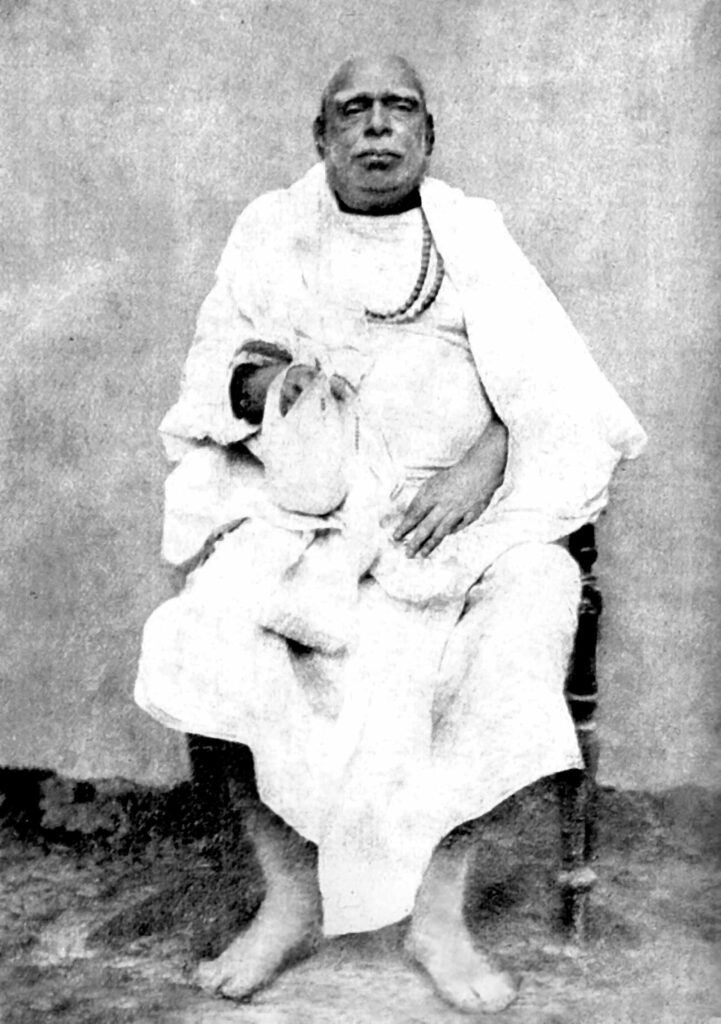
Srila Bhaktivinoda Thakur thus honored the houses of many persons, even persons who had formerly been opposed to him for one reason or another. His efforts served as inspiration for many other workers, and before long sufficient funds had been collected to erect a temple in Mayapur. While the foundation of the temple was being dug, a Deity of Adhoksaja Vishnu was found. By referring to the Gaudlya Vaisnava scriptures, the Thakur determined that this Deity was the very Deity worshipped and owned by Sri Jagannath Misra, the father of Sri Chaitanya Mahaprabhu. This discovery confirmed the authenticity of the site from yet another point of view – archaeological.
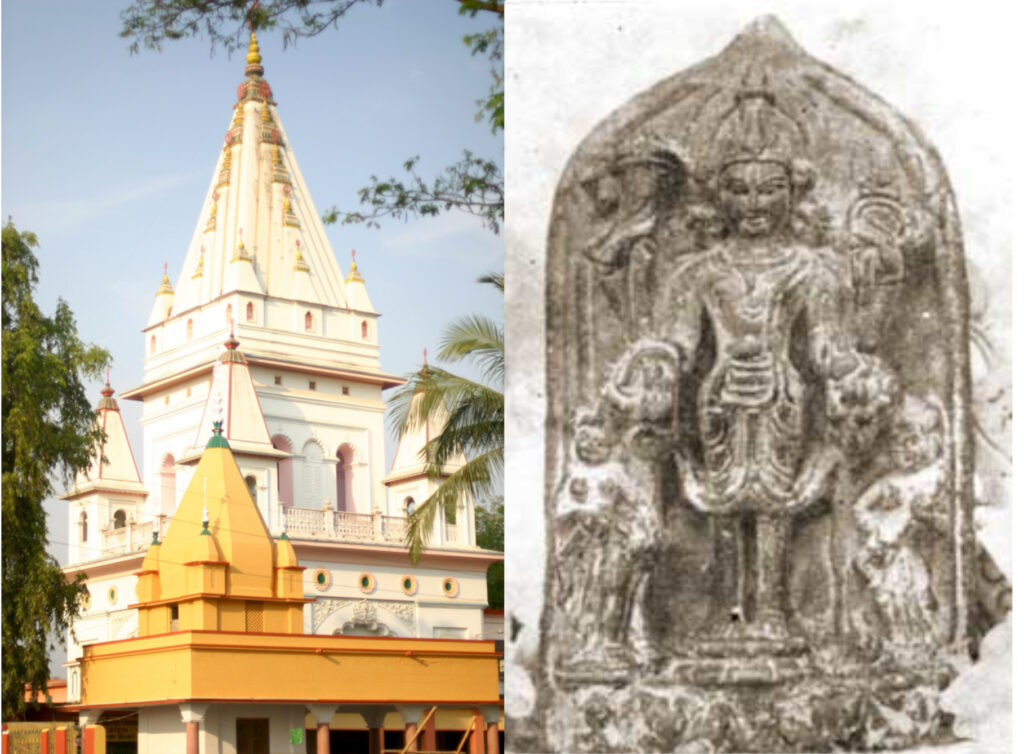
Deity of Adhoksaja Vishnu found at the site of the Yogapitha Temple
On March 21, 1895, on Gaura Purnima, the anniversary of Sri Gauranga’s birth, an enormous installation ceremony and sankirtan festival was held. Thousands of visitors attended, and the festival was compared by many participants to the famous Kheturi festival of Narottam Das Thakur which he organized 450 years ago to unite all the followers of Sri Chaitanya Mahaprabhu.
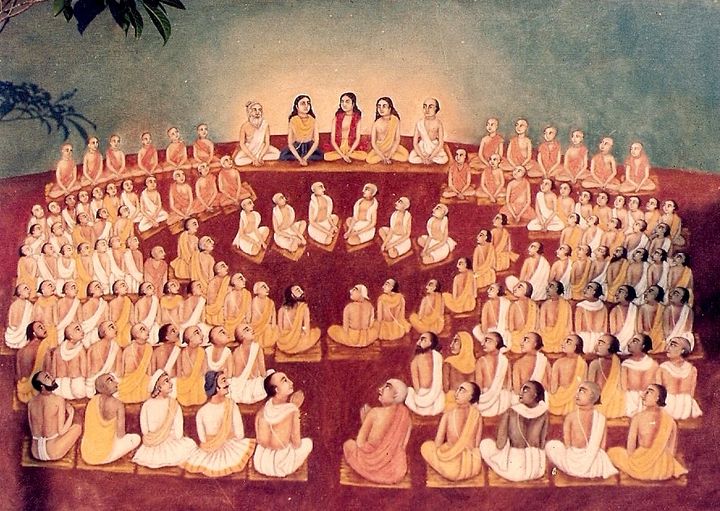
Kheturi festival of Narottam Das Thakur
Srila Bhaktivinoda Thakur recalls:
…there was an enormous Sri Murti installation festival and uncountable participants attended … there was Manoharasari kirtan … and nama-sankirtan, all with great bliss … envy had previously arisen from the inhabitants of present-day Navadvip over the finding of old [true] Navadvip. There had been some talk and a storm of abusive words for the worshippers of Gauranga. But for those who have offered their lives to the lotus feet of Gauranga, why would they be intimidated by the talk of wicked people? Not listening to the talk of the worldly-minded and envious, the devotees arranged to build a temple and worship the Lord.
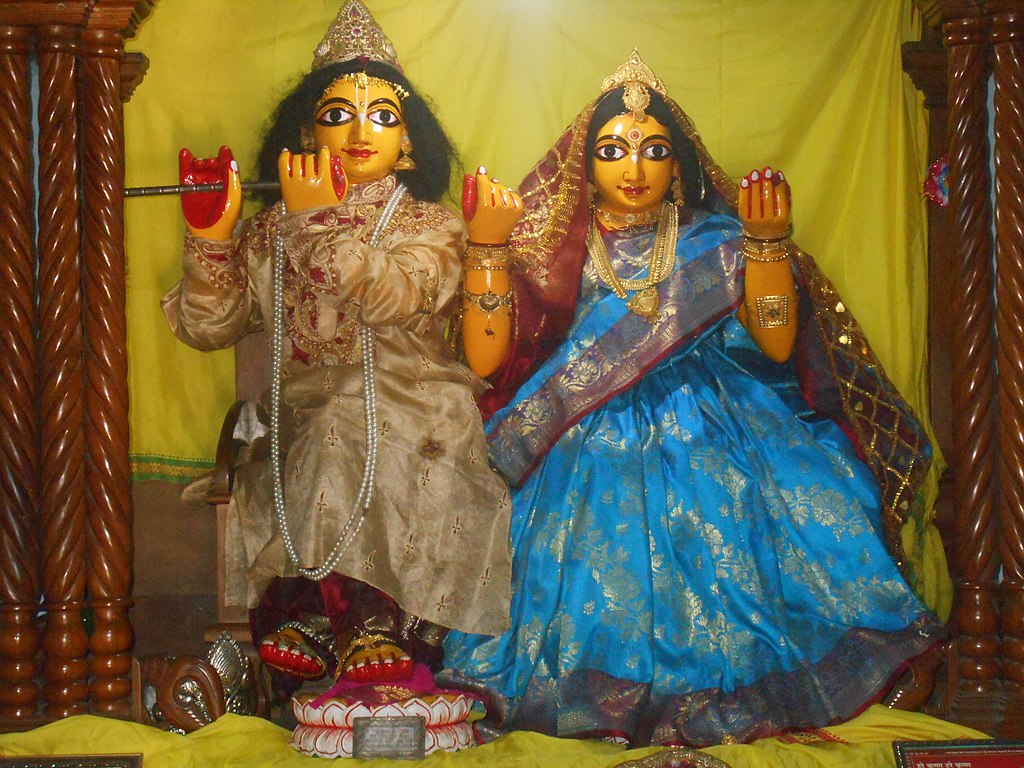
Deities of Lord Chaitanya and His consort Srimati Visnupriya installed at Yogapitha
The Thakur installed Deities of Lord Chaitanya and His consort, Srimati Visnupriya, and everything was conducted with great pomp. The birthplace of Sri Chaitanya Mahaprabhu was officially commemorated and its true location and importance was dramatically revealed to thousands of people. Thousands of Vaisnavas from all parts of India were present and took part in the ecstatic chanting, dancing and feasting. Most of the learned pandits of Navadvipa, after hearing the exhaustive evidence uncovered by the Thakur, finally admitted that this was indeed the place of Lord Chaitanya’s appearance.
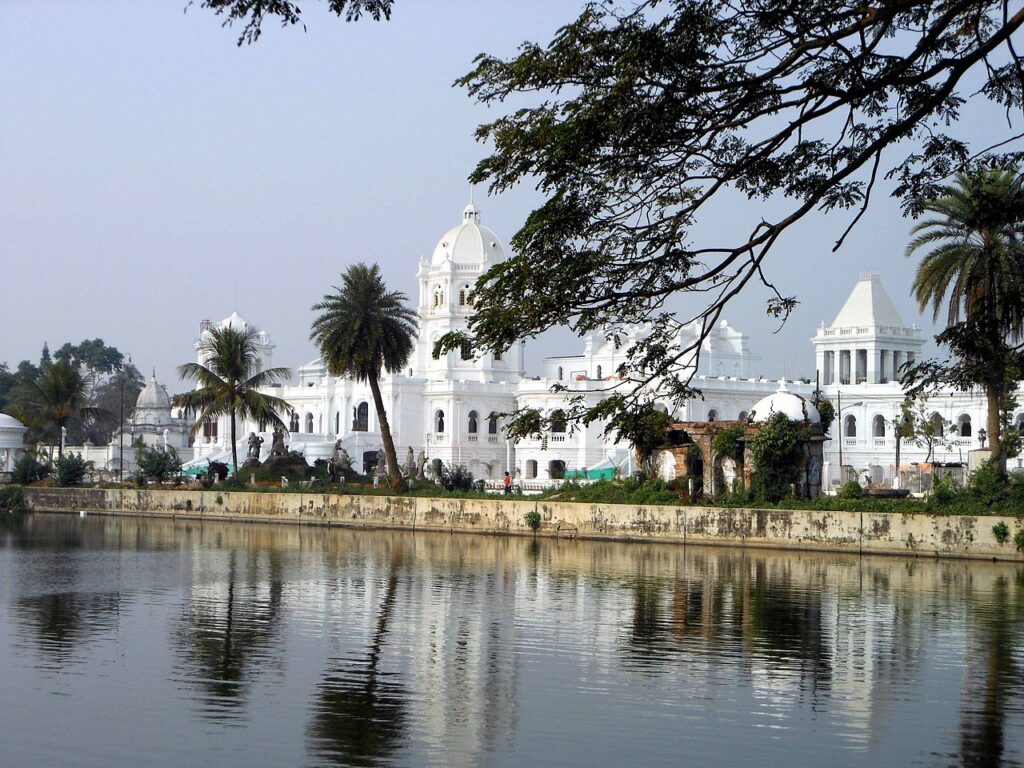
Viracandra Deva Maharaja’s Palace at Tripura
After this momentous celebration, the Thakur travelled to Tripura, a mountainous state, where Viracandra Deva Maharaja, who was devoted to Lord Vishnu, was king. The Thakur came at the king’s invitation in July of 1896, and for four days he preached about the glories of the Holy Name to the people there.
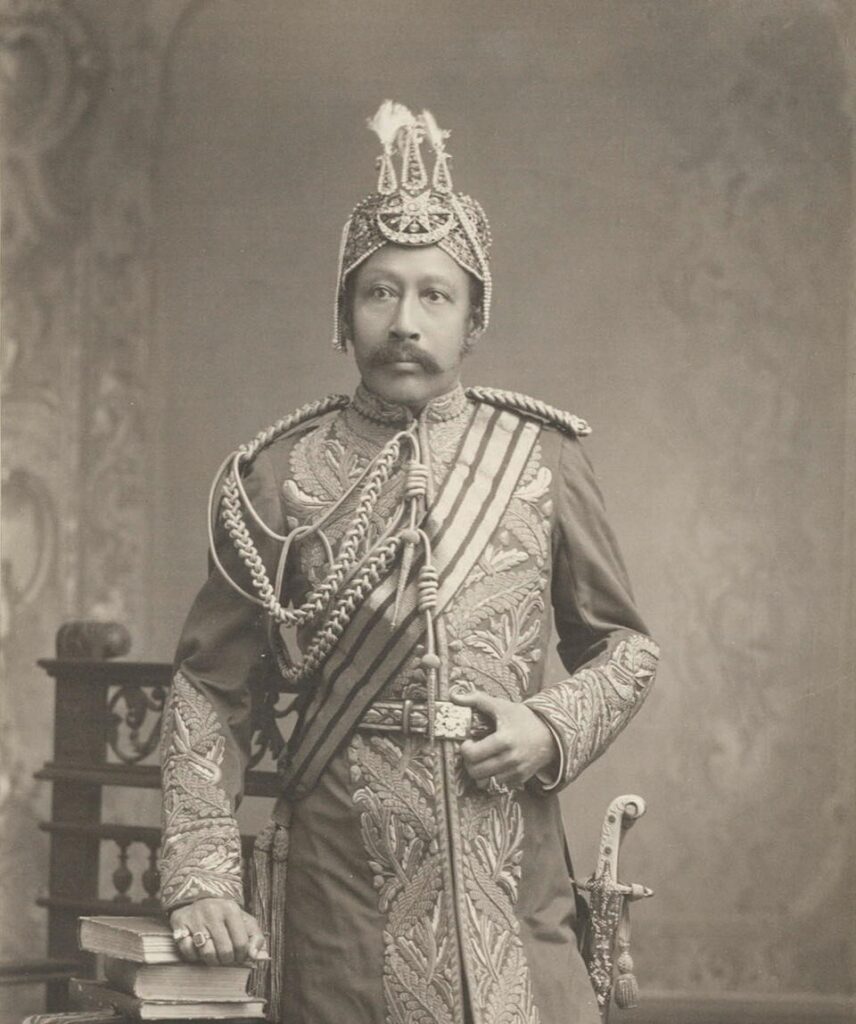
Viracandra Deva Maharaja of Tripura
On the first day he spoke about the eternal principles of devotion and the spiritual form of the Holy Name of Krishna. His lecture was filled with deep philosophical analysis and many quotations from the Vedic literature, unknown even to the many pandits and learned gentlemen in attendance. Upon hearing his talk, they became stunned with amazement at the erudition and deep realizations of the liberated paramahamsa. Many were able to grasp for the first time the transcendent nature of pure devotional service and the chanting of the Holy Names. For the next two days, the Thakur enlivened both the royal family and the general public by continuously speaking on Lord Chaitanya’s sublime pastimes.
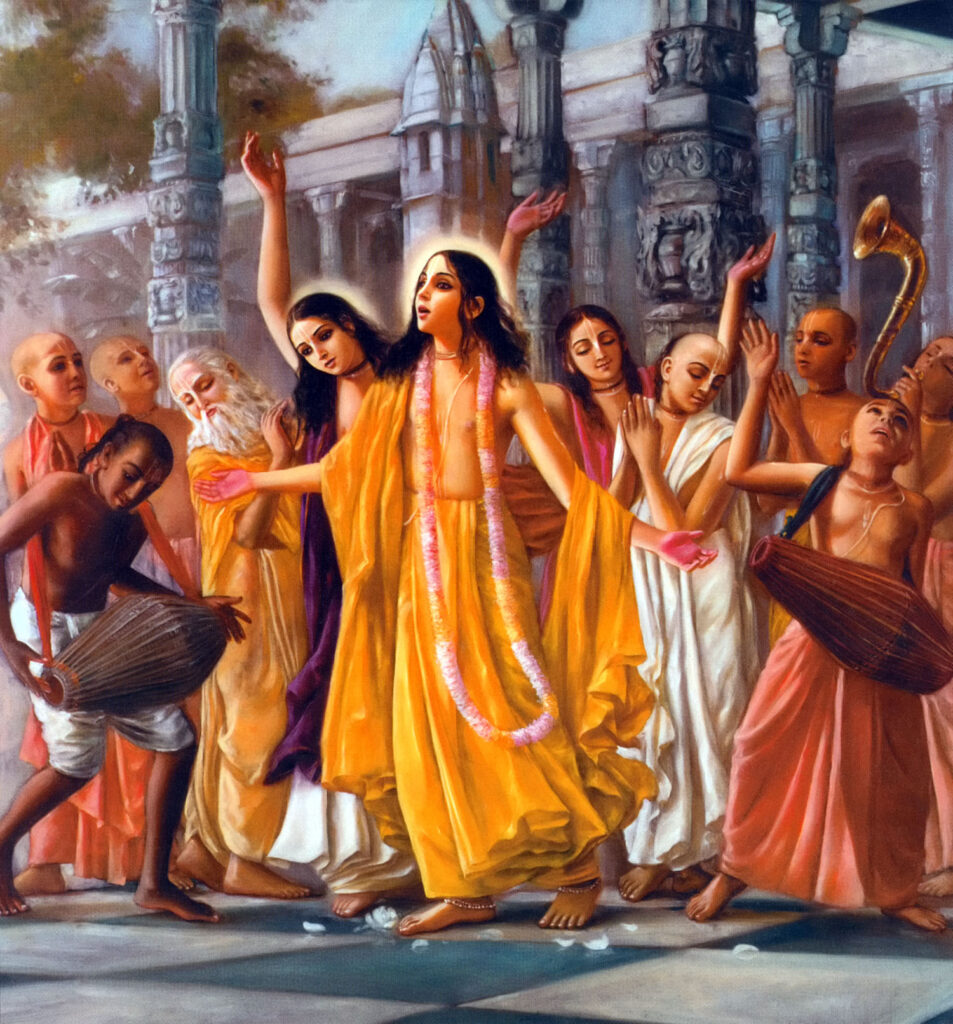
Returning from Tripura to his work with the Nama-hatta in Godrumadvipa, the Thakur toured all of the villages in the vicinity of Calcutta and Kumara Hatta, chanting the Holy Name and distributing the teachings of Lord Chaitanya. From the time of his retirement in 1894 until 1896 there was another incredible outpouring of preaching, writing and publication work. In 1894 he published Vedarka-didhiti, a Sanskrit commentary on Sri Isopanisad, along with a commentary by Baladeva Vidyabhusana and other commentaries as well. He also published Tattva-muktavall or Mayavada Sata-dusani, a book by Madhvacarya refuting the philosophy of Shankaracarya, with a prose Bengali translation.
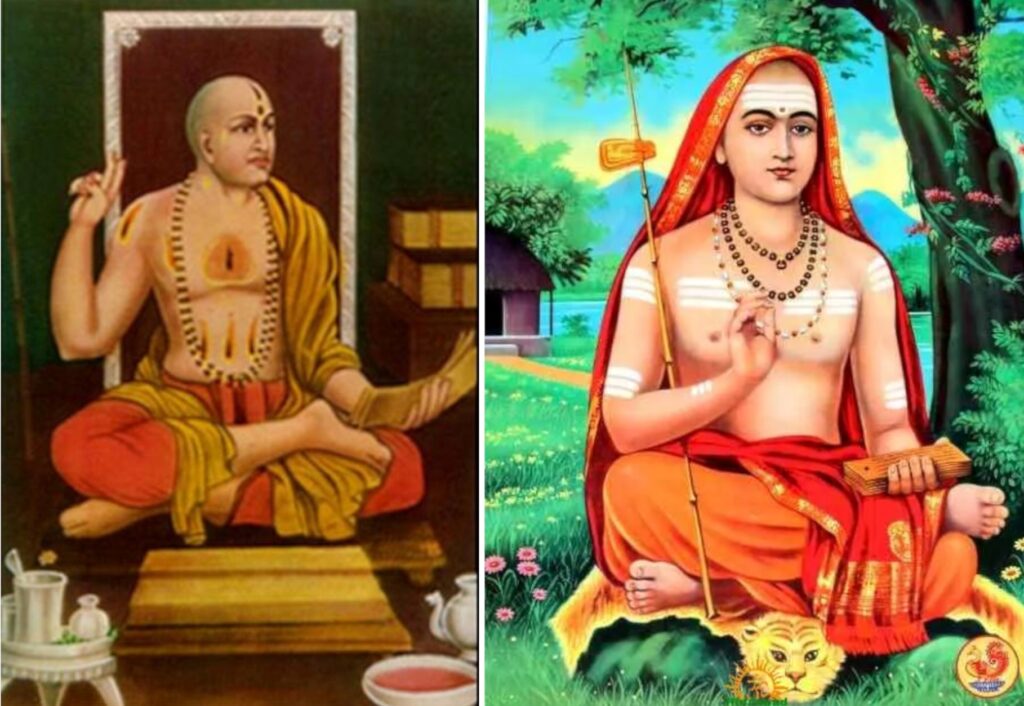
Madhvacarya and Sankaracarya
In 1895, the Thakur was in full stride with the publication of his Amrta-pravaha-bhasya, his commentary on Sri Caitanya-caritamrta; Hari-bhakti-kalpa-latika, a Sanskrit work about pure devotion by an unknown author and edited by the Thakur; Sodasa Grantha, sixteen small essays on Vaisnavism by Sri Vallabhacarya; Sri Gaurariga-stava-kalpataru, a twelve verse poem in Sanskrit from Raghunath Das Gosvami’s Stavavali; Manah-santosani, a Bengali translation of a Sanskrit work by Sri Pradyumna Misra; Mukunda-mala-stotram, by King Kulaksekhara, who was one of the twelve Alvars of South India.
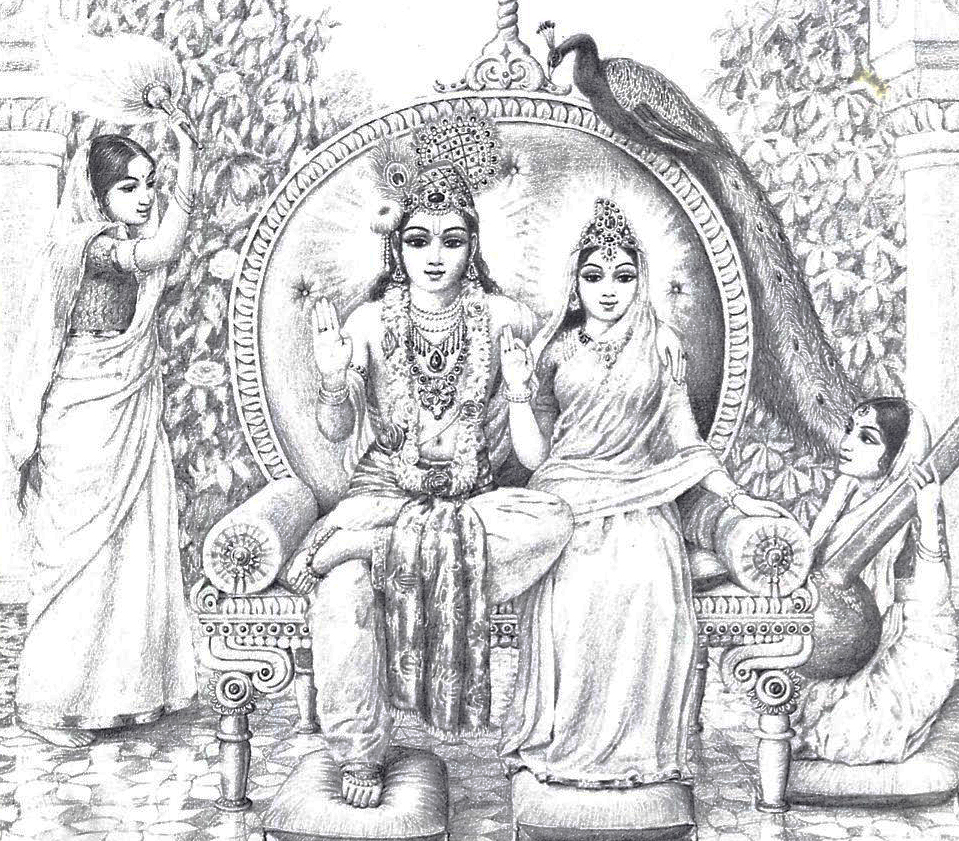
King Kulaksekhara
The Alvars – literally ‘those immersed’ [in God] – were Tamil poet-saints of South India who taught bhakti to Lord Vishnu; Sri Laksmi-carita by Gunaraja Khan, the author of Sri Krishna-vijaya; four nama-stotras from the Narada Pancaratra, and Sriman Mahaprabhor Asta-kaliya-lila-smarana-mangala-stotram, an eleven verse Sanskrit poem on the eight-fold daily pastimes of Lord Chaitanya, written by an unknown author.
Srila Bhaktivinoda’s Preaching Reaches the Western World
1896 was the momentous year in which the Thakur reached out to the West with his Sri Gauranga-lila-smarana-stotram, a book containing 104 Sanskrit verses and a condensed description of the pastimes and teachings of Sri Chaitanya Mahaprabhu, as found in Sri Caitanya-bhagavata and Sri Caitanya-caritamrta. The book began with a forty-seven page introduction in English prose entitled Sri Chaitanya Mahaprabhu: His Life and Precepts. This introduction summarizes the contents of the book’s Sanskrit verses and is one of the most concisely worded and wonderful descriptions of Lord Chaitanya’s life and teachings ever written. One can read Sri Chaitanya Mahaprabhu: His Life and Precepts on the Yoga Wisdom website: https://wisdom.yoga
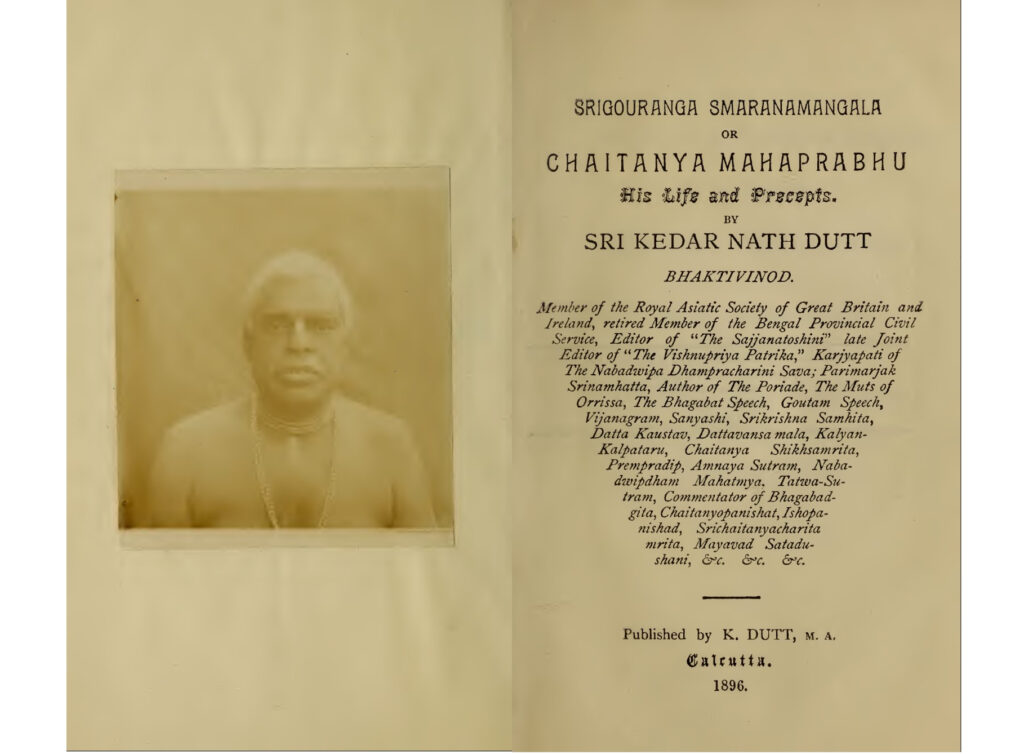
Accompanying the Sanskrit verses was a Sanskrit commentary entitled Vikasini Tika by the renowned pandita of Navadvipa, Maha-mahopadhyaya Sitikantha Vacaspati. The above-mentioned work was sent to various universities and intellectuals in different parts of the world. It was, in part, a reply to the American philosopher, Ralph Waldo Emerson, who had earlier expressed his regret in not being able to read the Sanskrit of the Thakur’s Sri Krishna-samhita.
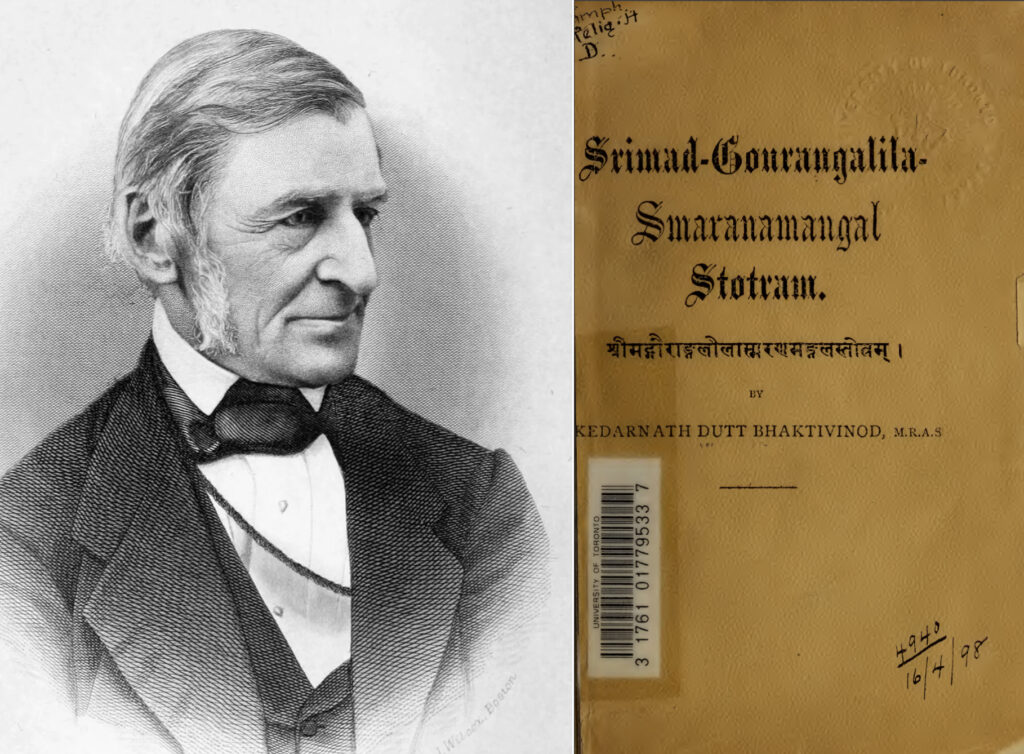
Ralph Waldo Emerson and cover of Bhaktivinoda Thakur’s book from McGill University Library
Emerson was a metaphysical author and philosopher who read and admired the Bhagavad-gita. Here was something the Westerners could easily read and profit from, and the book found its way into many of the major educational institutions in both hemispheres. It was discovered many years later by one of Srila Bhaktivedanta Swami Prabhupad’s disciples in McGill University in Montreal, and I have read, without being able to confirm, that it was also sent to Australia. 1896 was also the year of Srila Bhaktivedanta Swami Prabhupad’s birth, which he noted in his dedication to the Thakur in his book Teachings of Lord Caitanya:
Dedicated to The Sacred Service of Srila Saccidananda Bhaktivinoda Thakur Who Initiated The Teachings of Lord Chaitanya in The Western World (McGill University, Canada) in 1896, The Year Of My Birth.
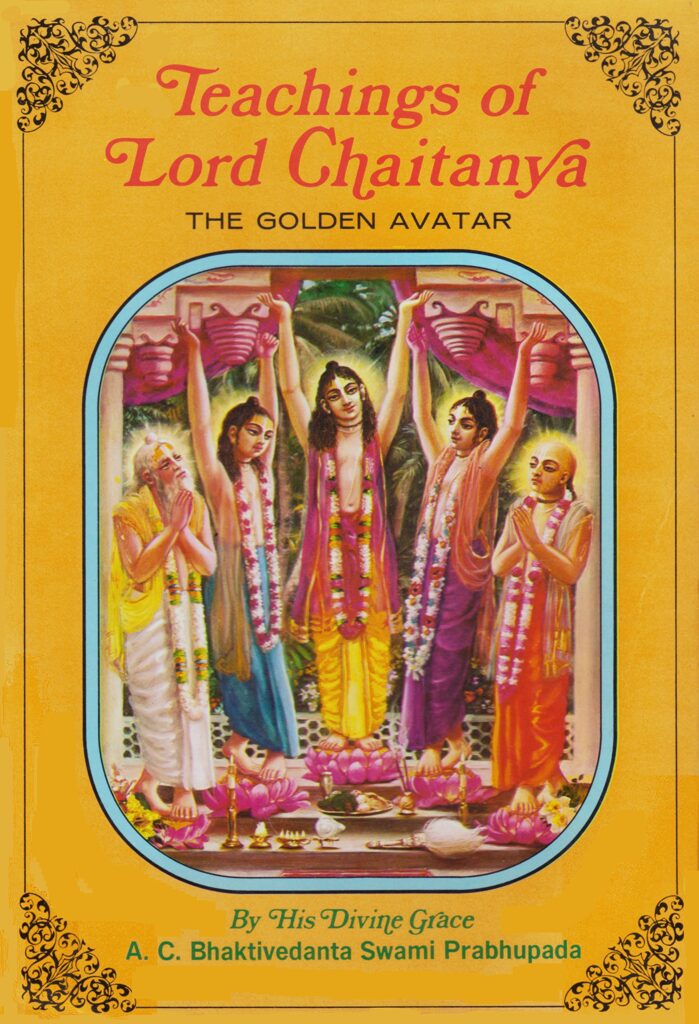
The two events occurred in the same year, and Srila Bhaktivedanta Swami, on a number of occasions, noted the spiritual significance. Furthermore, Srila Bhaktivinoda Thakur had predicted the day that Westerners would also embrace the teachings of Lord Chaitanya. In one of his articles written for Sajjana-tosani and published in 1885, he had not only predicted it, but prayed for it and invoked it:
Lord Chaitanya did not advent Himself to liberate only a few men of India. Rather, His main objective was to emancipate all living entities of all countries throughout the entire universe and preach the Eternal Religion. Lord Chaitanya says in the Chaitanya-bhagavata:
In every town, country and village, My name will be sung.
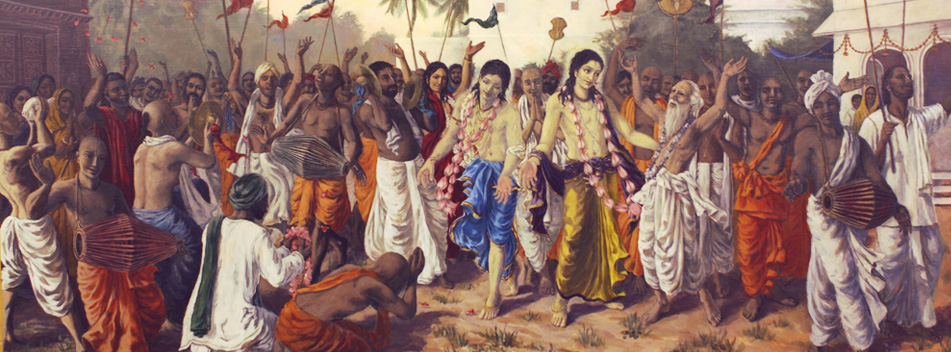
There is no doubt that this unquestionable order will come to pass … Very soon the unparalleled path of Harinama-sankirtan will be propagated all over the world. Already we are seeing the symptoms …
Oh, for that day when the fortunate English, French, Russian, German and American people will take up banners, mrdangas and karatals and raise kirtan through their streets and towns. When will that day come? Oh, for the day when the fair-skinned men from their side will raise up the chanting of ‘jaya sacinandana, jaya sacinandana ki jay’ and join with the Bengali devotees. When will that day be? On such a day they will say, ‘Our dear Brothers, we have taken shelter of the ocean of Lord Chaitanya’s Love; kindly embrace us.’ When will that day come? That day will witness the holy transcendental ecstasy of the Vaisnava-dharma to be the only dharma, and all the sects and religions will flow like rivers into the ocean of Vaisnava-dharma. When will that day come?
And then he penned another amazing prediction, which can be applied to Srila Bhaktisiddhanta Sarasvati Thakur, but also, most certainly, to Srila Bhaktivedanta Swami Prabhupad:
A personality will soon appear to preach the teachings of Lord Chaitanya and move unrestrictedly over the whole world with His message.
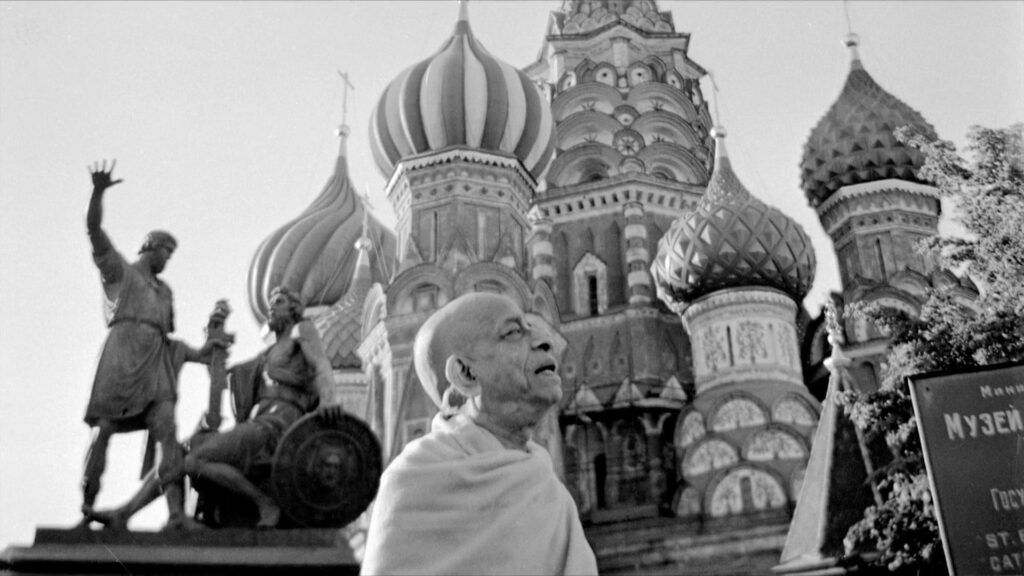
Srila Bhaktivedanta Swami would never take credit for his amazing achievements, and always gave credit to his divine master, Srila Bhaktisiddhanta Sarasvatl Thakur. In a purport in the Third Canto of Srimad-Bhagavatam, Srila Bhaktivedanta Swami states:
In the same order as Kardama Muni, about one hundred years ago, Thakur Bhaktivinoda also wanted to beget a child who could preach the philosophy and teachings of Lord Chaitanya to the fullest extent. By his prayers to the Lord he had as his child Bhaktisiddhanta Sarasvati Gosvami Maharaja, who at the present moment is preaching the philosophy of Lord Chaitanya throughout the entire world through his bona fide disciples.
[Srimad Bhagavatam 3:22:19]
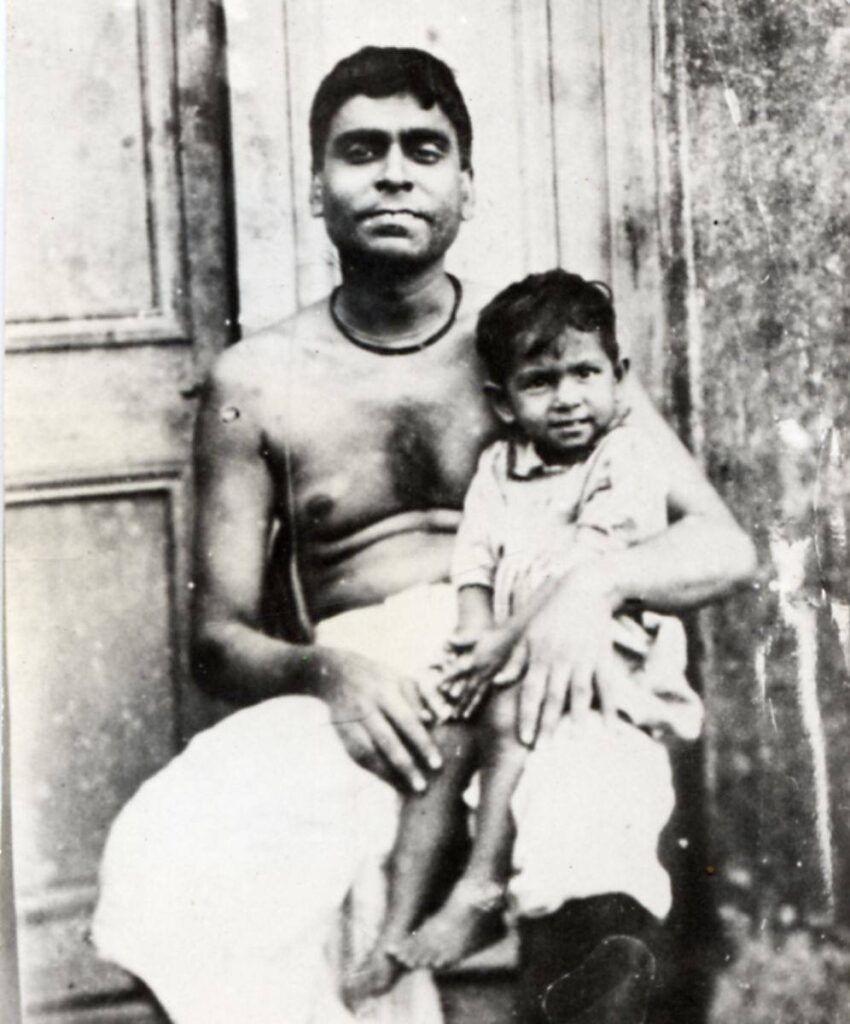
Srila Bhaktivinoda Thakur and young Bhaktisiddhanta Sarasvati
In that same year of 1896, the Thakur also published two works which explained the five main elements of the philosophy of Ramanujacarya at length; one which he authored, called Sri Ramanuja-upadesa, and the other, by Sri Pillai Lokacarya, called Artha-pancakara. The Thakur’s Sri-Gauranga-lila-smarana-marigala-stotram, containing the Life and Precepts essay, was favorably reviewed by a number of scholars. One Western scholar named R.W Frazer, who had spent time in Madras, wrote this appreciation:
Five hundred years have passed away since the time Chaitanya spread a faith in the saving grace of Krishna throughout the land. Nevertheless, down to the present day, the same spirit that inspired Chaitanya continues still to dwell among his followers.
In an interesting account of the life and precepts of Chaitanya lately published by his devout and aged follower, Sri Kedarnath Dutt Bhakti-Vinod, it can be read how this spirit preserves its vitality undiminished amid the changes that are sweeping over the land. This exponent of the hopes of the present followers of the teachings of Chaitanya declares his firm faith, that from a devoted love to Krishna, a love like that of a girl for a loved one, shown by constant repetition of his name, by ecstatic raptures, singing, calm contemplation and fervour, a movement will yet take place to draw to the future church of the world ‘all classes of men, without distinction of caste or clan to the highest cultivation of the spirit.’ This church it appears, will extend all over the world, and take the place of all sectarian churches, which exclude outsiders from the precincts of the mosque, church or temple.
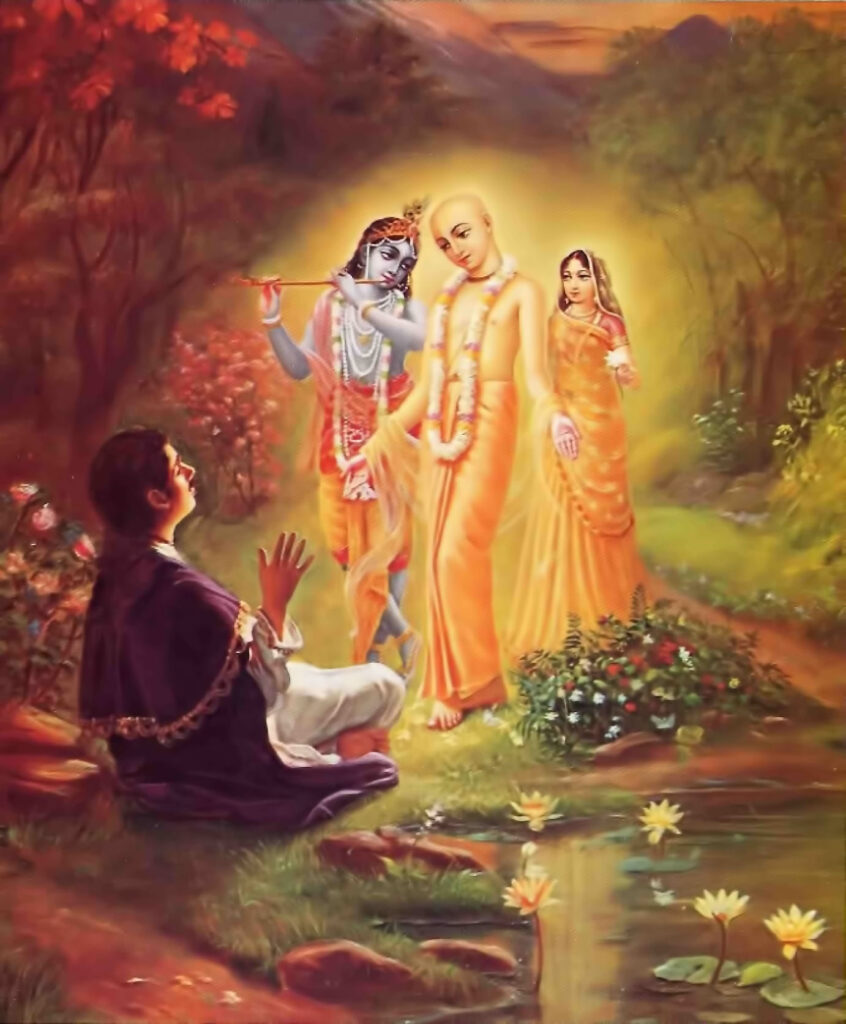
The spirit that is to animate this new church is to be founded on the principle that ‘spiritual cultivation is the main object of life. Do everything that keeps it and abstain from doing anything which thwarts the cultivation of spirit.’ A devoted love of Krishna is to be the guiding light, as preached by Chaitanya. ‘Have a strong faith that Krishna alone protects you and none else. Admit Him as your only guardian. Do everything which you know Krishna wishes you to do and never think that you do a thing independent of the holy wish of Krishna. Do all that you do with humility. Always remember that you are a sojourner in the world, and you must be prepared for your own home.
[From A Literary History of India pp. 349-51]
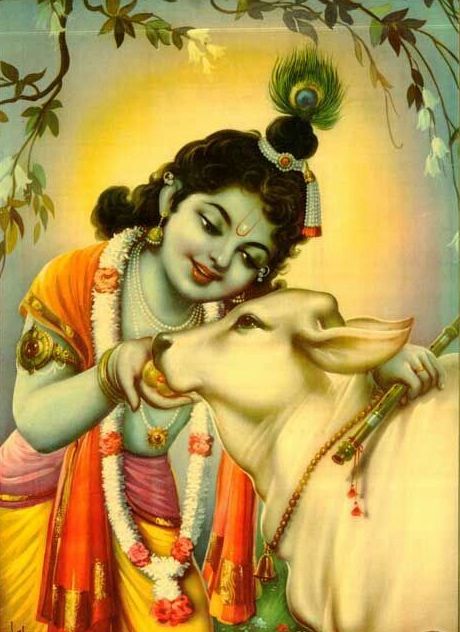
Preaching and Publishing Until the Last
During the rainy season of 1896, at the request of the Maharaja of Tripura, who had earlier invited the Thakur to preach in his kingdom, the dauntless preacher spent several days preaching in Darjeeling and Karsiyam. In 1897 the Thakura travelled and preached in many villages and towns, such as Medinipur and Sauri, spreading Sri Chaitanya’s message and delivering the people of Bengal from the darkness of materialism and atheistic philosophy. The Thakur experienced great spiritual bliss and satisfaction in his preaching efforts, and 1897 also saw the publication of the fifth chapter of Brahma-samhita, published and edited by him, along with the original Sanskrit, Srila Jiva Gosvami’s Sanskrit commentary and Thakur Bhaktivinoda’s own Bengali introduction, Bengali prose translation and Bengali commentary called Prakasini.
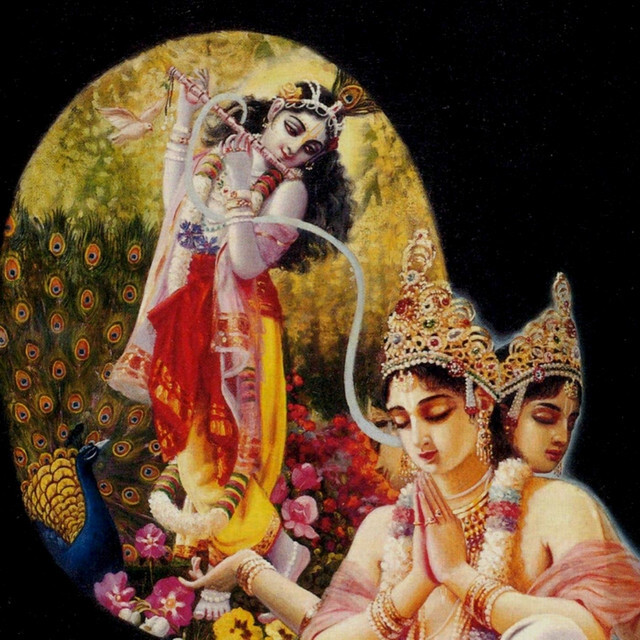
The Thakur’s association with the famous Sisir Kumar Ghosh has been documented by Paramananda Vidyaratna and in a scholarly book called Vaisnavism in Bengal by Dr. Ramakanta Chakravarti. Sisir Kumar Ghosh (1840-1911) was a famous journalist, the founder and editor of the Amrita Bazar Patrika newspaper and formerly a Brahmo (a follower of the impersonalist teacher Rammohan Ray). He had great respect and reverence for Srila Bhaktivinoda Thakur , having read some of his books, such as Sri Krishna-samhita. Being very attracted to the purity of the Thakur, he initiated a correspondence with him. He came to consider the Thakur to be on the level of the Six Gosvamls, and in fact, he once wrote to him:
I have not seen the Six Gosvamis of Vrndavan, but I consider you to be the seventh Gosvami.
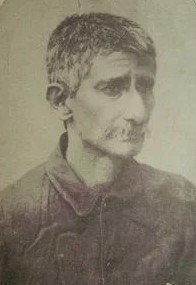
Sisir Kumar Ghosh
He published a book about the life of Lord Chaitanya in English called Lord Gauranga or Salvation for All in 1897, being inspired by the Thakur’s book Sri Chaitanya Mahaprabhu, His Life and Precepts. He wrote biographies of Lord Chaitanya’s followers and published an edition of the Chaitanya-bhagavata. He also preached the glories of the Holy Name in the Calcutta area and many villages in Bengal, being inspired again by the Thakur’s example. His Vaisnava journal, Sri Vishnu Priya O Ananda Bazar Patrika was published under the editorship of the Thakur on a fortnightly basis starting in 1890. Later it became a monthly.
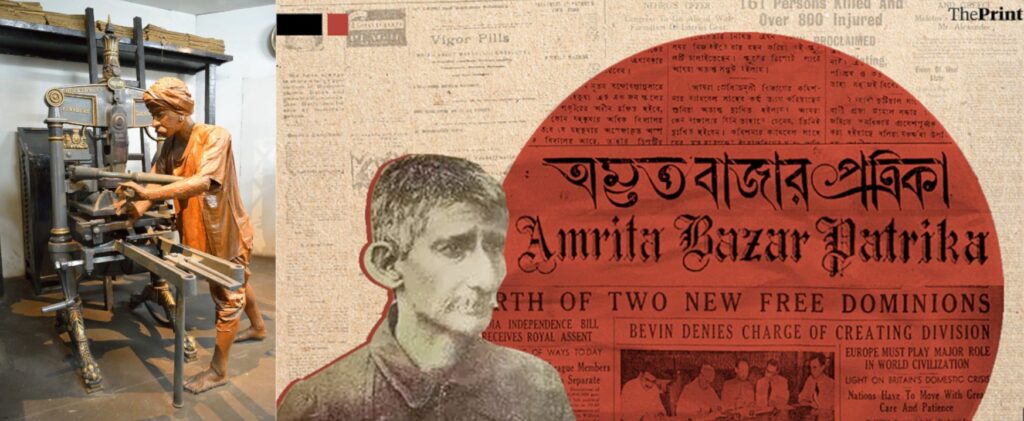
The Thakur severed his links with the magazine in 1899, because he felt the journal was indulging in prajalpa (idle or useless talk) by mixing Vaisnavism with the news of secular politics. Sisir Kumar was a nationalist, and he could not restrain himself from mixing in his views, which were very much opposed to the British Raj. The Thakur, on the other hand, being firmly situated in transcendence, could understand the futility of such indulgences and understood that the pressing need in human society was God consciousness. Men were spiritually all brothers. The business of dividing into camps of friends and enemies on the basis of the bodily conception of life had little to do with the Reality he was interested in communicating to the public.
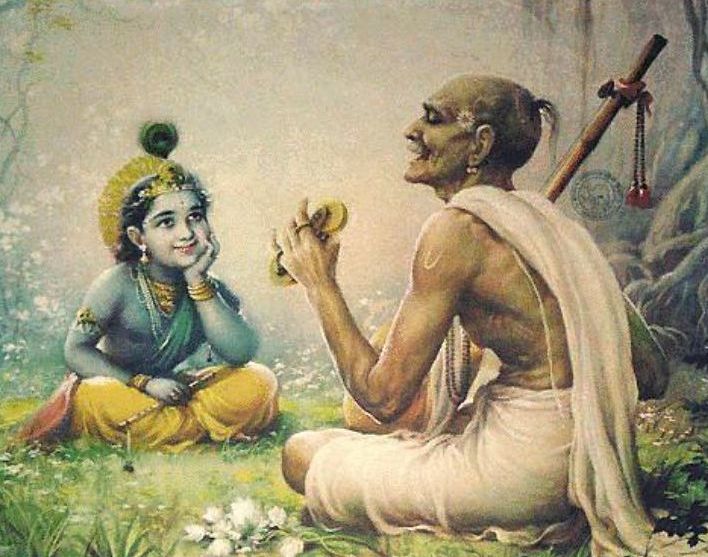
Srila Bilvamangala Thakur
During the years of 1898 and 1899, the Thakur was fully absorbed in preaching, book publishing and bhajan. In 1898 the great work called Sri Krishna-karnamrta by Srila Lilasuka Bilvamangala Thakur was published by Srila Bhaktivinoda Thakur with the original Sanskrit, the Bala-bodhinl-tika commentary of the older brother of Kavi Karnapura, Chaitanya Das Gosvami, a final summary, and Bengali prose translations of the verses. In the same year he wrote a commentary on the Upadesamrta of Srila Rupa Gosvami [later translated by Srila Bhaktivedanta Swami as The Nectar of Instruction.] He published an edition of Bhagavad-gita with the commentary of Sripada Madhvacarya, and Sri Goloka-mahatmyam, the second khanda of Sanatan Gosvami’s Brhad-bhagavatamrtam [the story of Gopa Kumar’s return to the spiritual world] with the original Sanskrit, and his own Bengali translations of the verses.
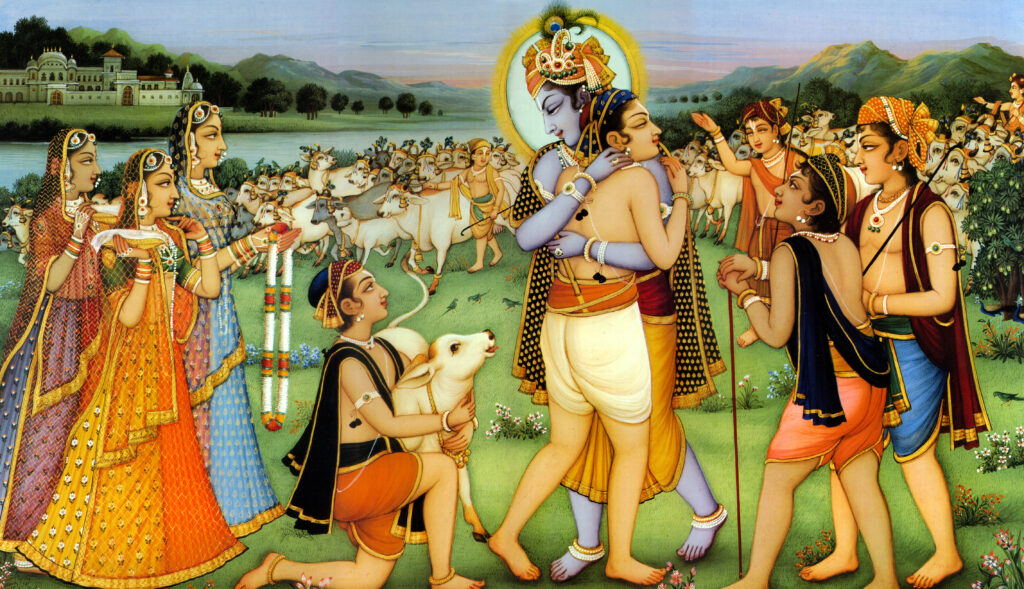
Gopa Kumar Returns to the Spiritual World
In 1899 the Sanskrit classic of Srila Narahari Sarakara called, Sri Bhajanamrta was brought to light and translated into Bengali by the Thakur. Narahari used to please Lord Chaitanya by waving a chamara or a peacock fan. [Srila Thakur Bhaktivinoda’s Gaura-arati song glorifies this: narahari adi kori camara dhulaya.]
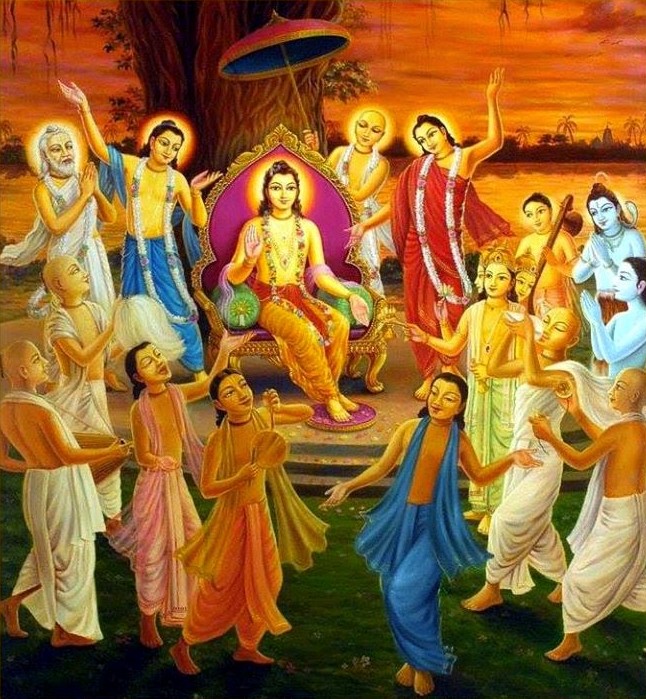
Sri Gaura Arati
And in the same year, the highly elevated 168 verse work called Sri Navadvipa-bhava-taranga, which describes the sites of Navadvipa from the point of view of a fully realized soul, was presented. These places are not described as geographical or historical entities of this world, but rather as Isodyana or the ‘transcendental garden of the Supreme Lord.’ I have quoted a few verses from this amazing book:
In the southern portion of Mayapur, on the bank of the river Ganga and very near its junction with the river Sarasvati, is the extensive grove called Isodyana (The Lord’s Garden.) May that Garden be the place of my eternal devotions. In this Garden, my Lord Sri Sachi-nandana performs the midday pastimes along with His devotees. Seeing the brilliance of this grove, I shall be reminded of Radha Kunda in Braja. May all these areas be eternally visible to my eyes.
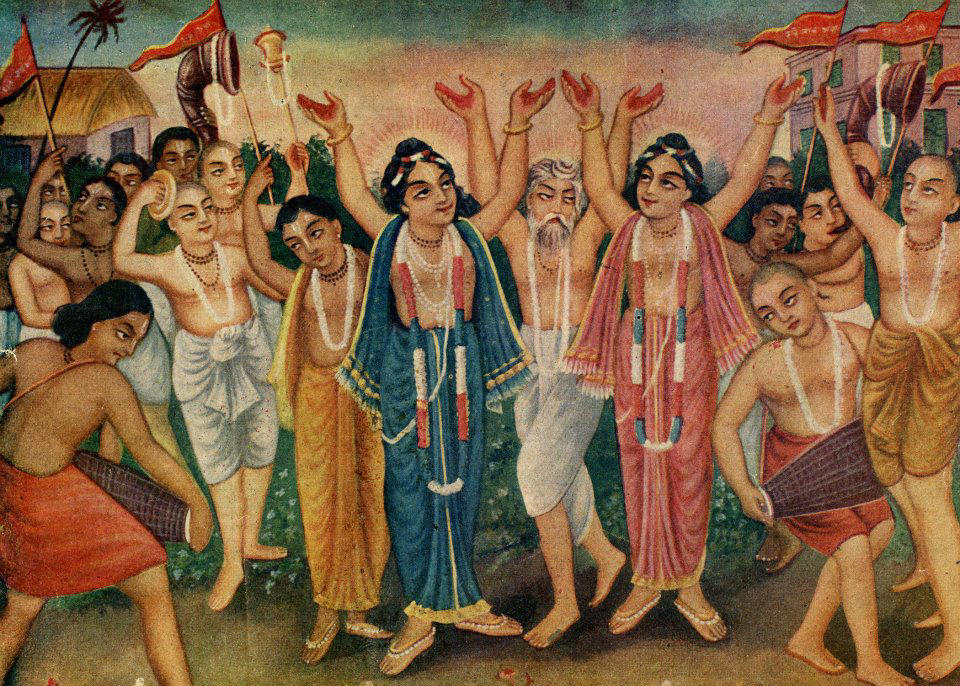
Huge trees and dark vines appear very dense. Among the foliage are various types of birds singing the transcendental glories of Lord Gaura. There is a large lake and an extremely opulent temple glowing with pure gold inlaid with diamonds as well as blue and yellow sapphires. The materialists, with their eyes bewildered by the illusions of material sense perception, and who are envious of the Lord, can never see these groves. Rather, they see only a small piece of land covered with thorns, periodically thrown into utter disruption by the forceful flooding of the river.
[Sri Sri Navadvipa Bhava Taranga part 1 verses 26-29]
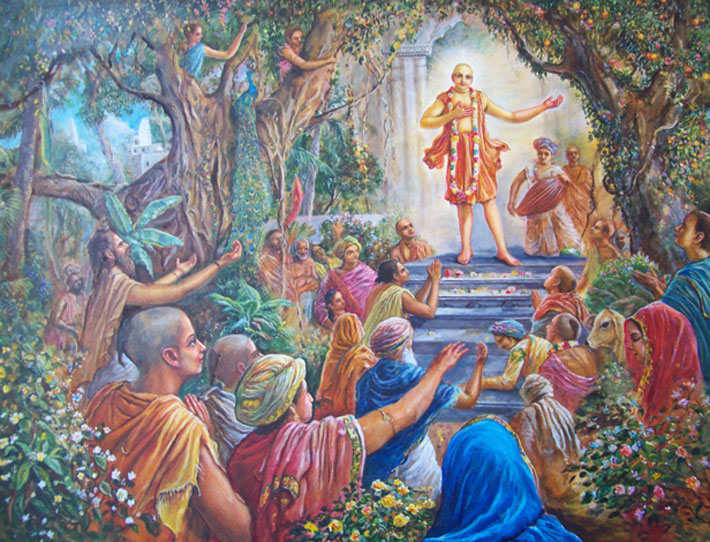
In this work, the Thakur revealed that his svarup, his eternal spiritual identity, was Kamala-manjari, the eternal assistant of Ananga-manjarl. In the Sri Sri Radha-Krishna-ganoddesa-dipika, Srila Rupa GosvamI explains that Ananga-manjarl is one of the “vara,” or supermost gopis, and sister to Srimati Radharani. Lord Balarama’s wives were Srimati Varuni-devi and Srimati Revati-devi, and they appeared as wives of Lord Nityananda as Srimati Vasudha-devi and Srimati Jahnava-devi.
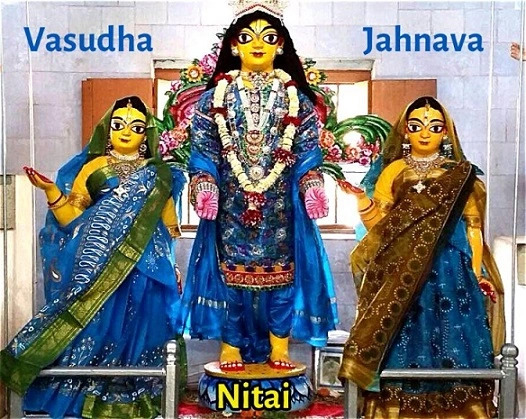
This is explained in the Sri Gaura-ganoddesa-dipika of Srila Kavi-karnapura. Both Vasudha-devi and Jahnavi-devi are considered to be incarnations of Ananga-manjari. This means that Srila Bhaktivinoda Thakur is the assistant of the eternal consort of Lord Nityananda. Knowing this, it becomes clear why Godruma-dvipa, and particularly Svananda-sukhada-kunja, where Lord Nityananda inaugurated his preaching in Bengal – the Marketplace of the Holy Name – was the especially dear site of worship for Thakur Bhaktivinoda.
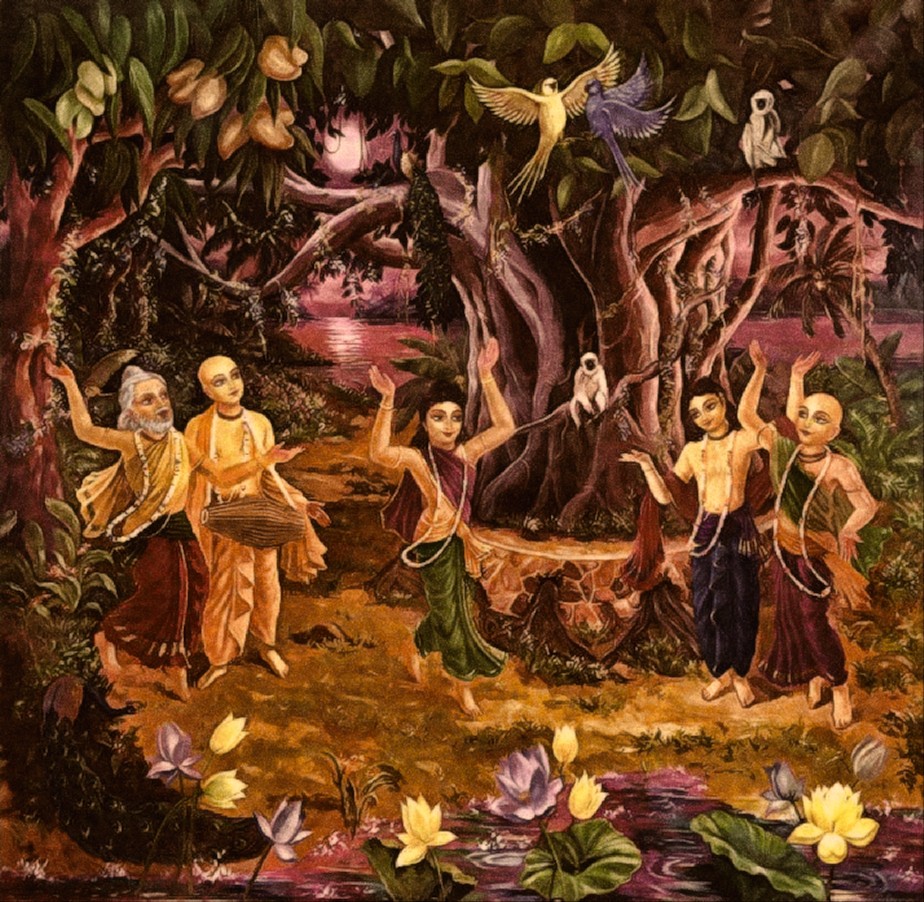
Bhakti Kuti and Svananda-sukhada-kunja
At the turn of the century, Srila Bhaktivinoda Thakur was inspired to return to Jagannath Puri, the site of the final pastimes of Sri Chaitanya Mahaprabhu. His son, Srila Bhaktisiddhanta Sarasvati Thakur, who had recently been initiated by Srila Gaurakisora Das Babaji, was staying there performing bhajan in the renounced mood of his gurus at the Gandharvika Giridhari Temple, which was located just near the samadhi of Srila Haridas Thakur. In order to facilitate his son’s worship, the Thakur had the temple repaired and cleaned. Daily, they gave lectures, and the Thakur established a place of bhajan a short distance from the ocean, also near the samadhi of Haridas Thakur, which he called Bhakti Kuti.
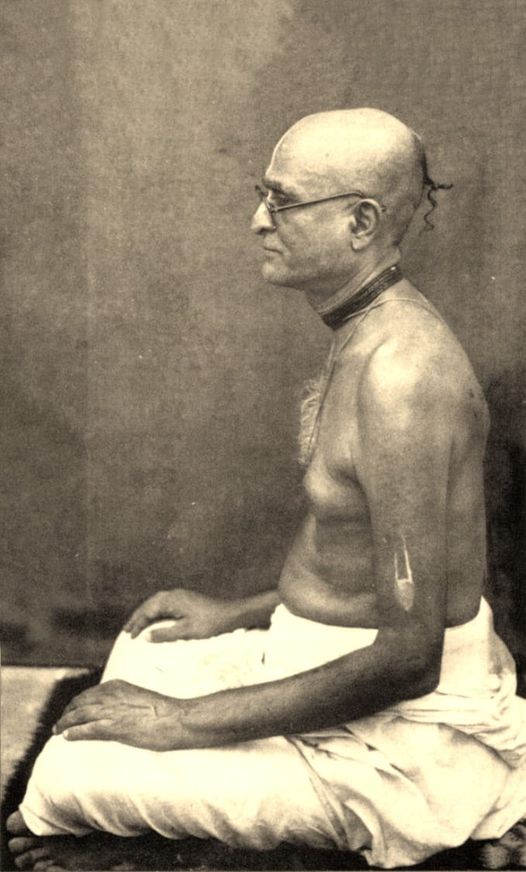
Srila Bhaktisiddhanta Sarasvati
A devotee named Krishna Das Babaji, who later became the disciple of the Thakur, stayed in Puri as an assistant and became very dear to Srila Bhaktivinoda Thakur. He continued to serve him up to the last moment of the Thakur’s life, and, feeling intense separation from his master, gave up his own life a year later. His samadhi is found just next to the Thakur’s in Godrumadvipa. At Bhakti Kuti, the Thakur performed his bhajan in solitude. He lived in a tiny room on the second floor, looking towards the samadhi of Haridas Thakur. His biographers state that occasionally some impious rascals tried to disturb him, but Krishna protected him in every respect. A number of sincere persons also came there to see him, however, and they were inspired and saved by his association and blessings, which he readily gave them.
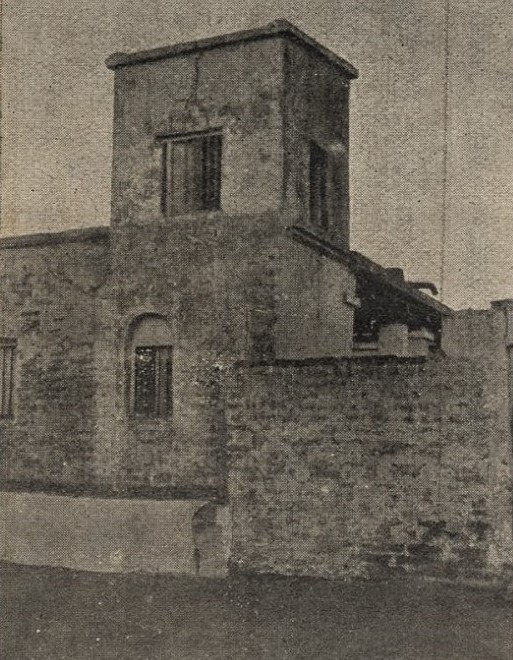
Bhakti Kuti – the place of bhajan of Srila Bhaktivinoda Thakur in Puri (picture taken in the 1930s)
The Thakur stayed in Puri for some time, before returning to his house at Godruma –Svananda-sukhada-kunja, the bhajan-kutira of Srila Bhaktivinoda Thakur. In 1900, one of his most important works, Sri Harinama-cintamani, was published. It presented the teachings of Srila Haridas Thakur about the Holy Name and other important aspects of spiritual practice, as collected from various Gaudiya Vaisnava literatures. It was divided into fifteen chapters and composed in Bengali verse form.
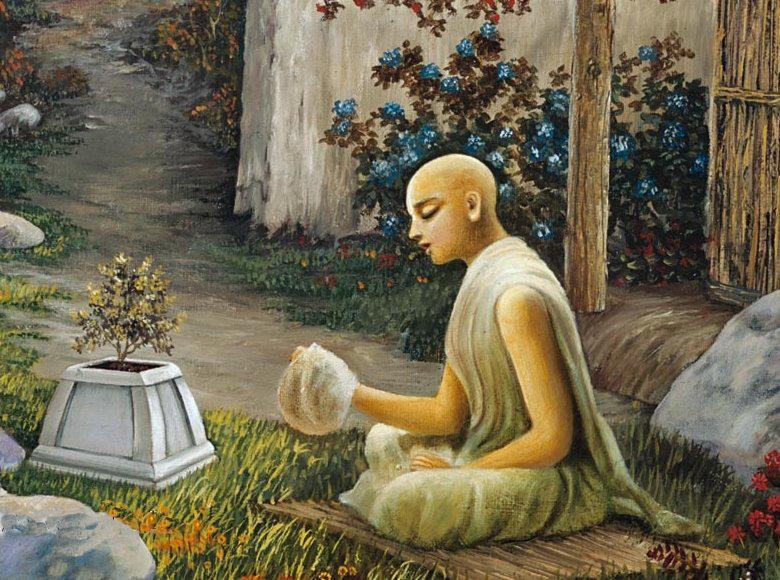
Srila Haridas Thakur
In 1901 he published Srimad-Bhagavatarka-marici-mala. In this important book, the Thakur presents a study of the Srimad-Bhagavatam in twenty chapters, arranging its principal verses so as to illustrate the divisions of sambandha (the soul’s relationship with God), abhideya (the means for reviving that relationship) and prayojana (the ultimate goal of life). The Sanskrit verses were accompanied by Bengali prose translations and explanations by the Thakur. The Srimad Bhagavatam is compared to the sun, and each chapter is considered to be an individual ray of Bhagavata sunlight.
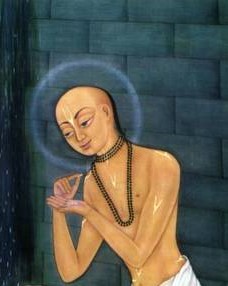
Sri Svarupa Damodara
In his concluding remarks, Srila Bhaktivinoda describes how he came to write the book as he did:
How I was inspired to compile this work is a mystery which I felt improper to disclose as it might constitute spiritual conceit. Subsequently, I realised that it would be a slight against my spiritual master which might stand as an obstacle on the path of my spiritual progress, and therefore, without any shame, I record the fact that, while under the benediction of my guru … I was meditating deeply upon the Srimad-Bhagavatam one day, when in a vision Sri Svarupa Damodara, the intimate adherent of Lord Sri Chaitanya Mahaprabhu, instructed me to compile the verses of the Bhagavata in accordance with the principles of sambandha, abhideya and prayojana as set forth by Sri Chaitanya, so that the book could be read with an easy understanding and with happiness by the devotees of the Lord. Sri Svarupa Damodara further guided me by giving me a wonderful explanation of the first verse of the Bhagavata, and he also showed me how I was to explain the verses in the light of the Gaudiya Vaisnava philosophy.
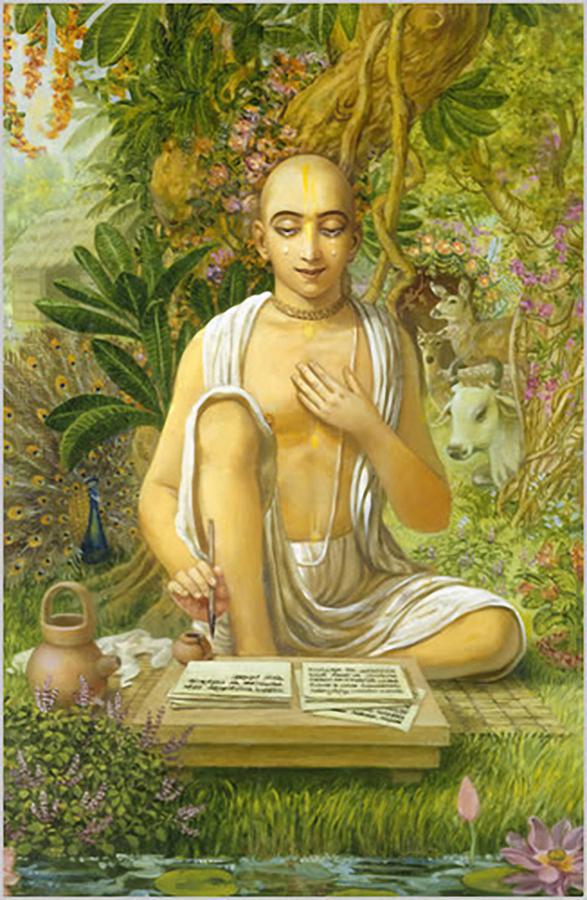
Visvanatha Cakravati Thakur
In the same year the Thakur published an edition of Padma Purana, as well as the Sankalpa-kalpadruma by Srila Visvanatha Cakravarti Thakur, with Bengali prose translations by Thakur Bhaktivinoda. In 1902 he brought out a supplement to Harinama-cintamani called Bhajana-rahasya. It was arranged in eight chapters, and the chanting of each chapter is to be observed in correspondence with each three hour period of the twenty-four hour day. Each chapter corresponds also to one verse of Sri Chaitanya Mahaprabhu’s Siksastakam and deals with one of the eight steps in the gradual development of Krishna-bhajan as is enunciated by Srila Rupa Gosvami in his Bhakti-rasamrta-sindhu.
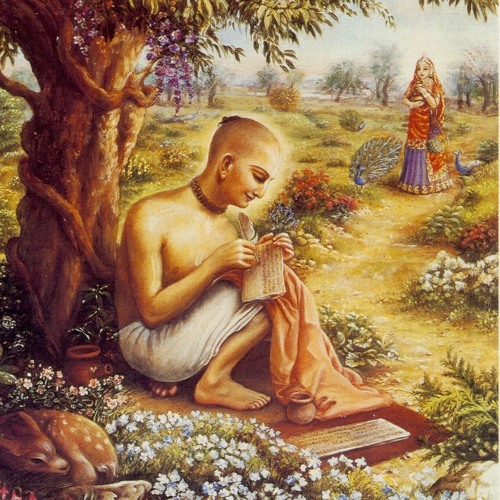
Srila Rupa Gosvami
All the chapters are filled with scriptural quotations explaining the philosophy and practice of worshiping Krishna. Each Sanskrit verse is accompanied by the Thakur’s Bengali translation in both prose and verse. This was one of his last major works, and it can be observed that the subject matter of the Thakur grew increasingly more elevated and esoteric as time passed.
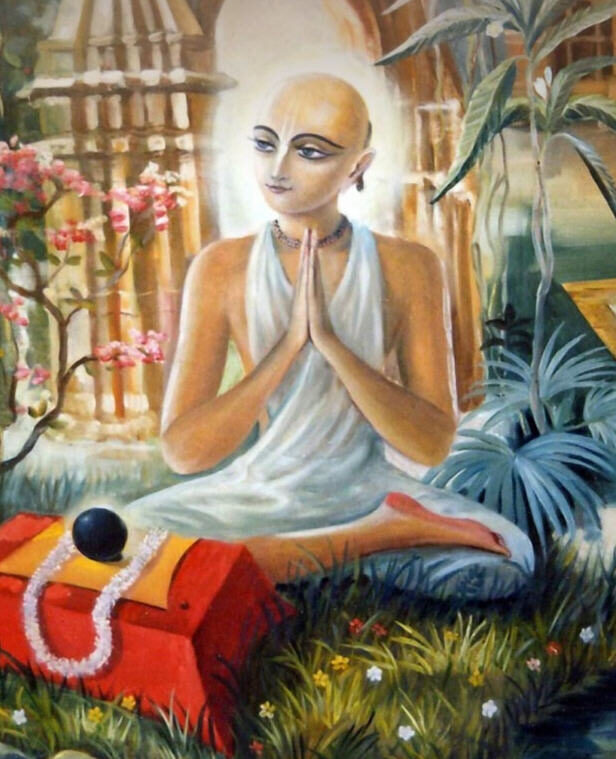
Gopala Bhatta Gosvami
In 1904 he published Sat-kriya-sara-dipika, a Sanskrit work by Gopala Bhatta Gosvami on the samskaras (purificatory rites) and other practices pertinent to both Vaisnava grhasthas (householders) and renunciates. He gave his own Bengali translations as well. In 1906 he published the Bengali verse classic Prema-vivarta, a book by Jagadananda Pandita, (the incarnation of Satyabhama, wife of Lord Krishna and incarnation of Goddess Bhumi). Jagadananda explains his loving mood with Lord Chaitanya and the glories of the Holy Name.
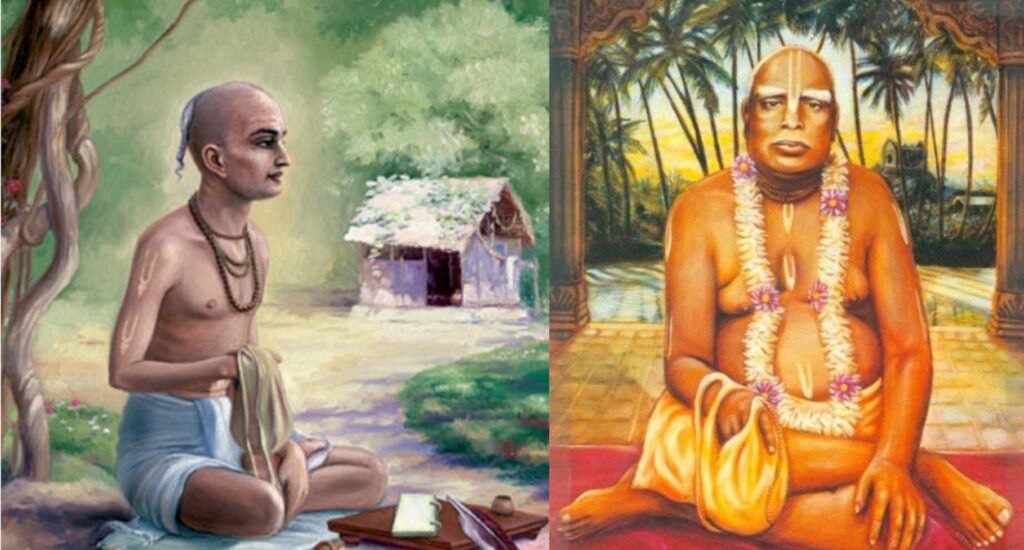
Srila Raghunath Das Goswami and Srila Bhaktivinoda Thakur
The last known work of Srila Bhaktivinoda Thakur was called Sri Sva-niyama-dvadasakam, (‘Twelve Verses Of Self-Imposed Regulative Principles’) written in 1907. The Sanskrit stava was modeled after the stava of Raghunath Das Gosvami called Sva-niyama-dasakam, which was comprised of ten verses of self-imposed vows. This work was a final statement of the Thakur’s, an illuminating set of instructions regarding preparation for the spiritual realm of existence, and his expressed determination not to budge from the path established by Srila Rupa Gosvami. I have quoted three of these instructive verses:
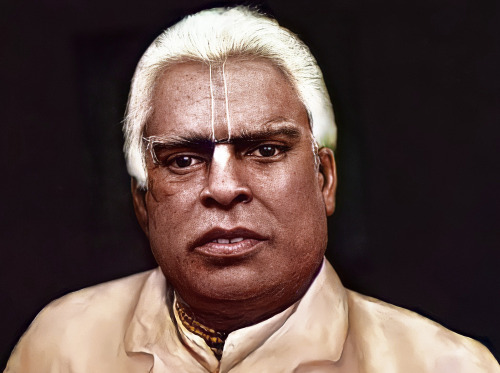
I have no attachment at all for the caste divisions of society [varnas] and I certainly do not identify with any of the social orders of life [asramas]. I have not the least fondness for religion or for sinful life in this world. Instead, I desire to perform whatever duties are required for the maintenance of my body of dull matter, so long as they facilitate my performance of pure devotional service.
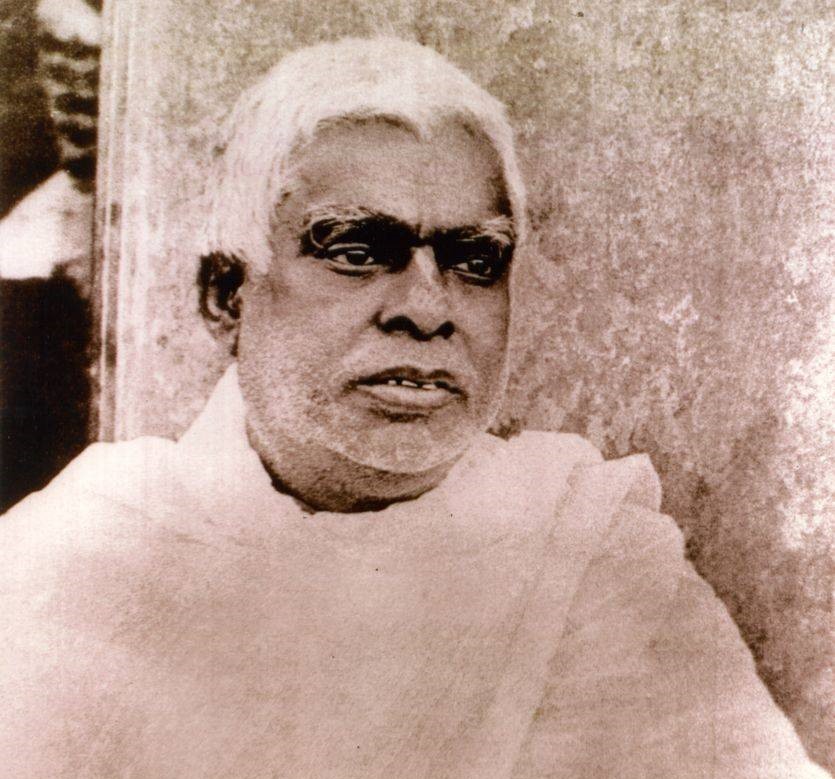
My austere vow is devotion to the lotus feet of Sri Hari. Thus I have chosen to cultivate the following in myself: great humility, simplicity, tolerance in all circumstances, respect for others, and compassion. Those transcendental activities alone are mine which are recommended by devotees of the lotus feet of the Lord, and which are found described in books that are full of the imperishable character and pastimes of Sri Chaitanya.
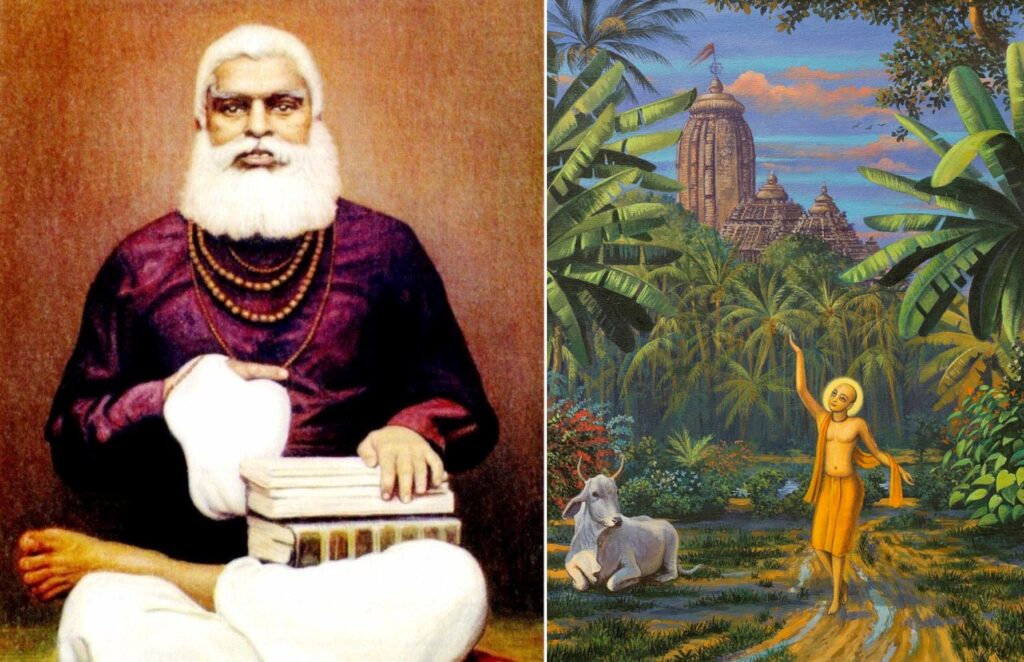
I have no longing for residence in the kingdom of Vaikuntha, nor for sense gratification or material works. I will never cherish the desire for attaining impersonal liberation, even for a second. There are, moreover, pastimes of Sri Hari that are purifying [for the conditioned souls], yet they are different from the bliss experienced in Vraja, and being devoid of any relationship with Sri Radhika, they give me no happiness at all.

Sir William Duke
The Thakur’s son, Lalita Prasad Thakur, in his biographical notes, tells the story of Sir William Duke. In 1908, just three months before the Thakur adopted the order of paramaharlisa [babaji-vesa sannyasa] one of his sons, who at the time was working at the Writers’ Building in Calcutta, came home one day and informed his father that Sir William Duke, Chief Secretary of Bengal, was in Calcutta. The Thakur had previously worked with this gentleman as a magistrate. The next day the Thakur made an appointment to meet him and went down to the Writers’ Building. Sir William met him just outside the building and escorted him to his office with folded hands. He said:
My dear Kedaranatha, when you were District Magistrate, I wanted to take you out of office. I thought that if there were many men as qualified as you in Bengal, then the English would have to leave.
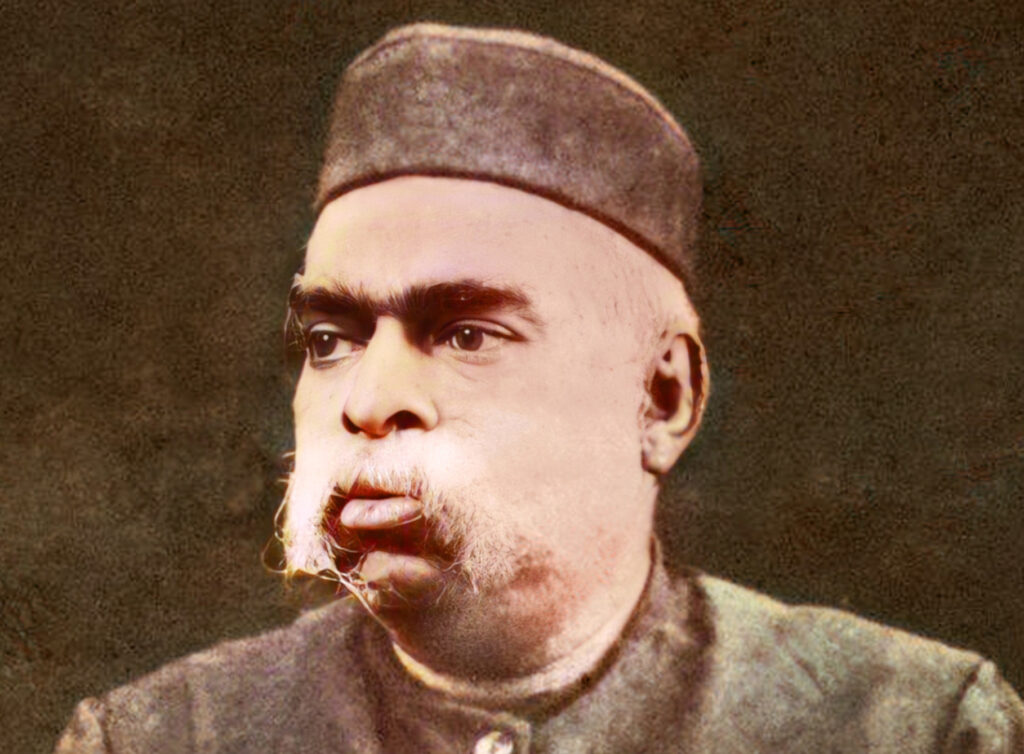
Sir William used to read the judgments that the Thakur passed in his court cases and was amazed at the great wisdom they reflected. On several occasions, he visited the Thakur at his home and observed how he was absorbed in his writing of Sri Caitanya-Siksamrta. The Thakur’s wife used to feed him a lunch of puri, luci (similar to a puri) and sweets whenever he came. He was astounded at the constant activity of the Thakur. He then admitted that he had considered the Thakur’s extraordinary abilities a threat to British control. But now he begged the Thakur’s forgiveness. The custom at that time of an English gentleman was that when a man grows old, he would approach everyone he had ever offended and beg their pardon, so that he could pass away peacefully. After hearing Sir William Duke’s apology, the Thakur replied:
I considered you to be a good friend and well-wisher all along.
The Thakur admitted later to being astonished that this man had wanted to do him harm, but he was so pleased by his repentant attitude that he gave him all his blessings.
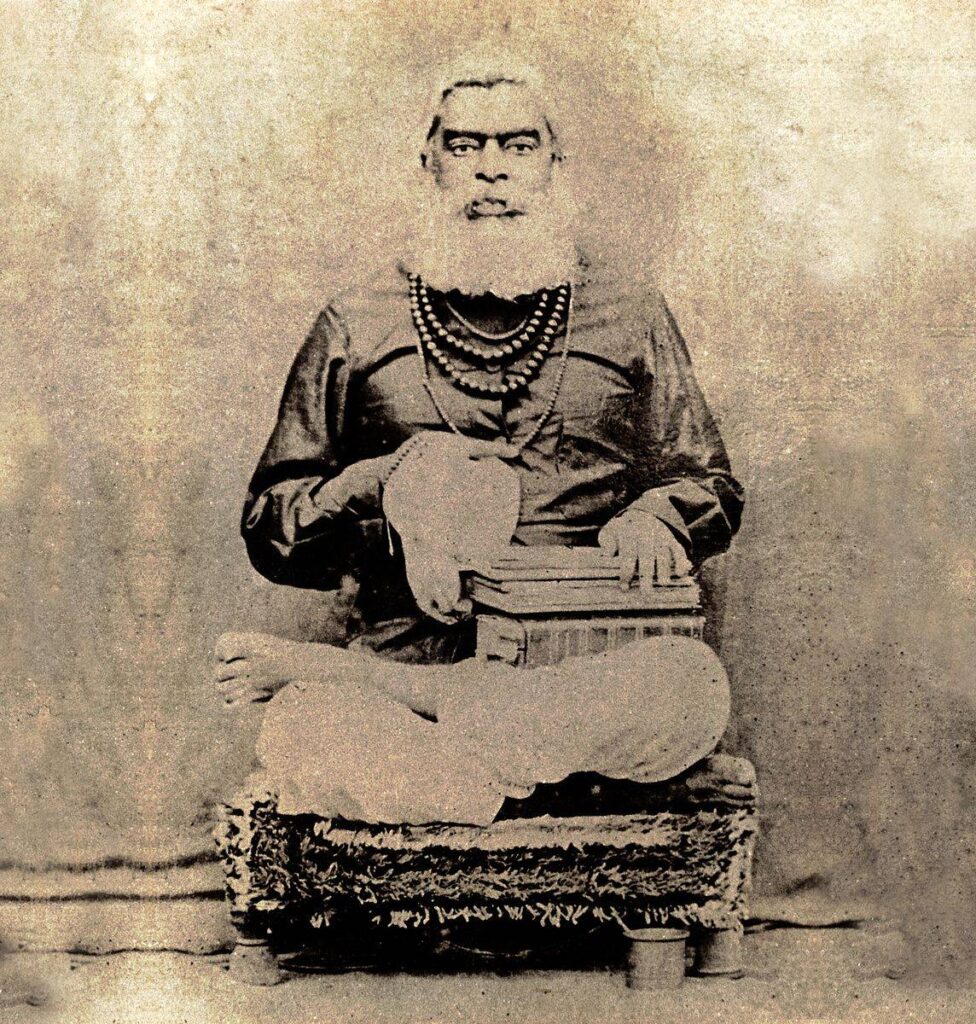
Acceptance of Babaji-vesa
Sundarananda Vidyavinoda has described how Srila Bhaktivinoda Thakur gave up household life and accepted initiation into the renounced order from Srila Gaurakisora Das BabajI Maharaj. One day in 1908 the Thakur followed the BabajI as he went from the Thakur’s house in Godrumadvipa to the boat ghata, where he would cross the Ganges and go to Navadvipa. As he followed him, the Thakur repeatedly asked him to give him initiation into the renounced order of life as a babaji. Gaurakisora Das Babaji felt that he was very fallen and unqualified, seeing the Thakur as his spiritual master, and thus, with great humility, he refused to become the Thakur’s vesa guru.
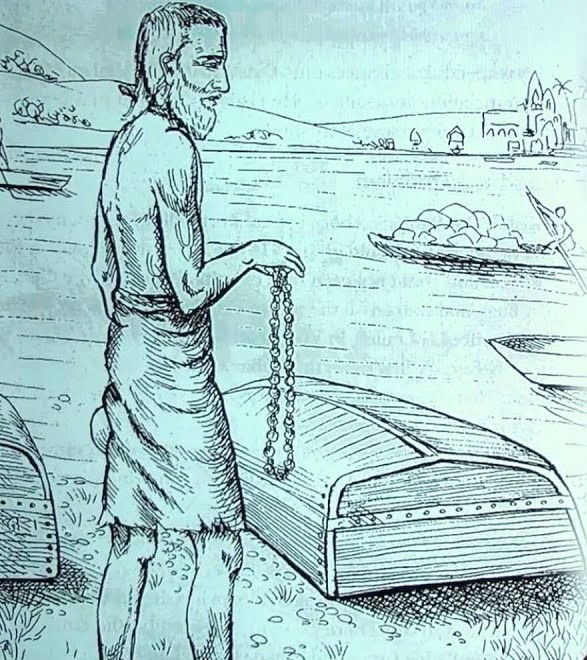
Gaurakishora Das Babaji Maharaj
Soon after this, the Babaji, by mystic intuition, could understand that the Thakur was very determined and was coming to Navadvipa to ask him again. In order to avoid him, the elderly Babaji went to the house of a known prostitute, near a marketplace in Navadvipa, and sat on her veranda for a while. He reasoned that if he had gone anywhere else, including the Ganges, he would have been discovered by the Thakur, but he would never be found in the house of a prostitute, for the Thakur would never enter such a place. Meanwhile, the Thakur, not finding Babaji Maharaj, could understand his uneasiness, and so he returned to Godruma. Babaji Maharaj then came out of hiding and went to the Radha-ramana Gardens, where he began to laugh uproariously. When questioned by a devotee who was present as to why he was laughing so much, he replied:
Today I have outwitted Kedaranatha Babu. I sat in that mataji’s house over there and not being able to find me, Kedaranatha Babu returned home.
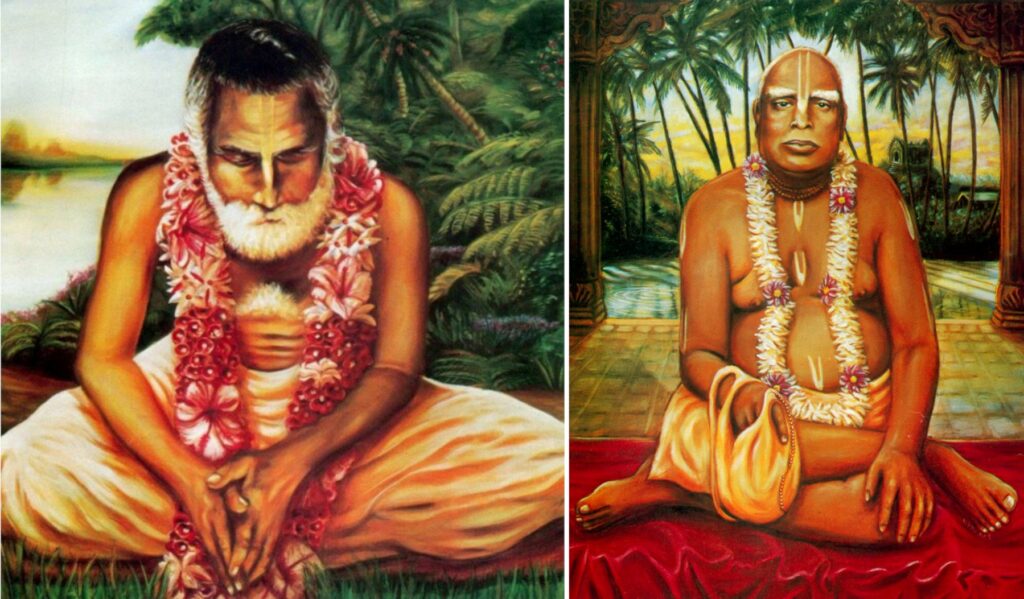
Gaurakishora Das Babaji and Srila Bhaktivinoda Thakur
A few days later, the Thakur sent one of his sons to Navadvipa to bring Babaji Maharaj to Svananda-sukhada-kunja. The Babaji agreed to come, and after staying for a few days, he consented to initiate the Thakur as a babaji. According to Gaurakisora Das Babaji Maharaj’s direction, the Thakur, in his presence, put on the old loin cloth and bahirvasa (begging apron) of Srila Jagannath Das Babaji, his siksa-guru, who had departed from the world some years earlier. By his verbal consent and his physical presence as a witness, Srila Gaurakisora Das Babaji Maharaj became the vesa guru of Thakur Bhaktivinoda.
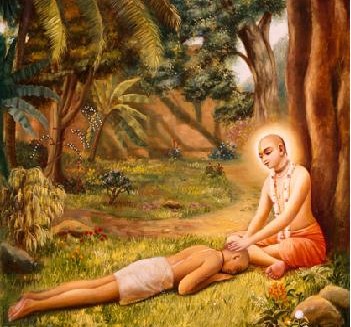
Srila Bhaktivinoda Thakur followed the example of Srila Sanatan Gosvami, who took the renounced order of life in the presence and with the consent of Lord Chaitanya by putting on the old white cloth of Tapan Misra. In this way, everything was done wonderfully, following the historical Gaudiya Vaisnava precedent. After this, the Thakur continued his chanting and writing, sometimes living in Godrumadvipa and sometimes in Calcutta at the Bhakti Bhavan.
Entering the Eternal Pastimes of the Lord
After taking to the renounced order of life, the Thakur accepted some disciples, and one of them, Krishna Das Babaji, continued to serve him as he had in Jagannath Puri. Feeling a strong desire to be fully absorbed in the spiritual plane, the Thakur shut himself up in Bhakti Bhavan in the year 1910, so that he could remain uninterruptedly engaged in the internal divine service of Sri Sri Radha and Krishna. Feigning paralysis before the eyes of common people, he entered into a state of total samadhi (spiritual trance).
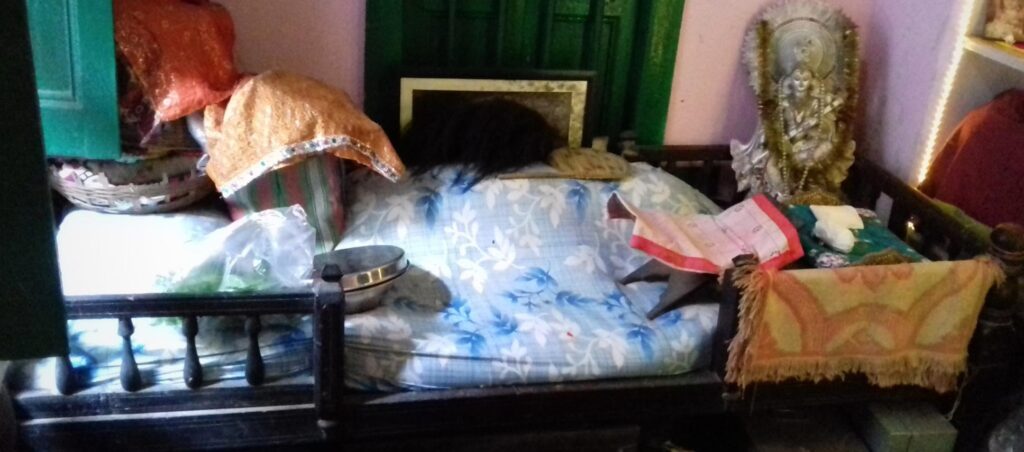
Srila Thakur Bhaktivinoda’s Room at Bhakti Bhavan in Calcutta (Kolkata)
On June 23, 1914, the sun began its southern course. It was the same day that Gadadhar Pandita, the incarnation of Srimati Radharani, had left the world some 450 years before. Precisely at noon, the Thakur entered the eternal pastimes of the Lord, far beyond the vision of the conditioned souls of this world. The Thakur’s samadhi ceremony was delayed until the sun began its northern course. At that time his last remains (his ashes) were taken from the Bhakti Bhavan in Calcutta and brought to his home in Godrumadvipa. There they were placed in a silver urn and buried in the midst of a huge kirtan and festival held in his honor by his disciples and friends. Hundreds took part, and his direct presence was experienced by everyone.
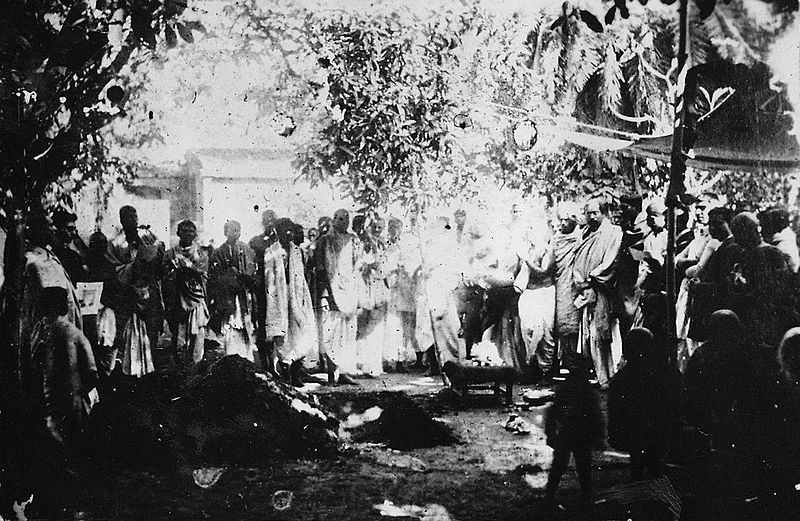
The Burial of Thakur Bhaktivinoda
The Thakur once wrote:
Let crowded sins repeat my trial scenes!
and lead me on from woe to woe!Care I for that? If love of God alone,
would bless my heart where’er I go.
The Holy seat of Love is Vrindaban,
where matter’s laws have no domainAh! when my panting soul shall find its rest
in that Eternal realm again!
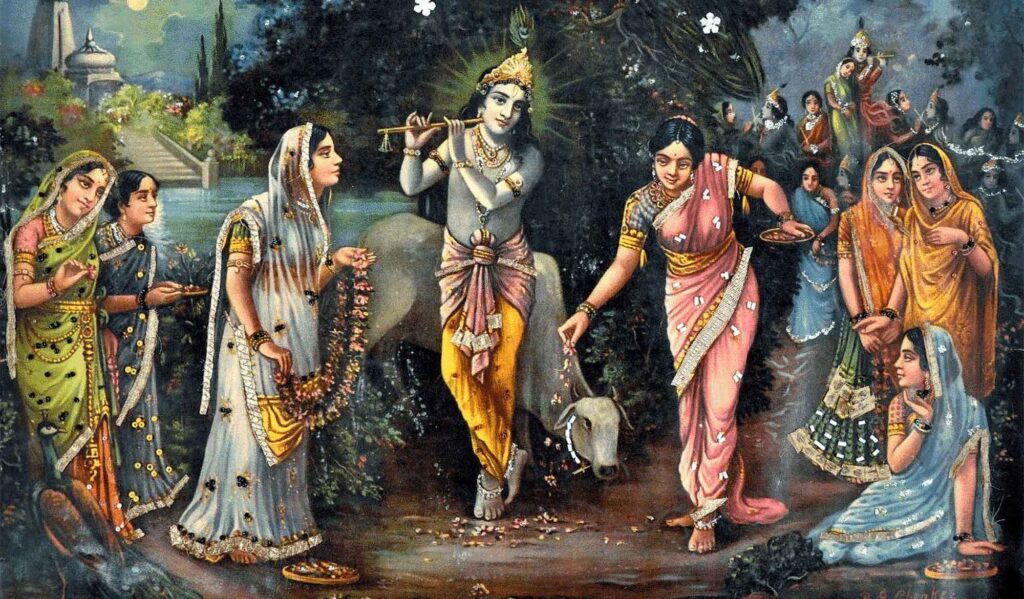
There could be no doubt that such a great soul would return to the Eternal realm. Pandit Satkari Chattopaddhyaya Siddhanta Bhusan was commissioned by the Thakur Bhakti Vinode Memorial Committee to write a short biography of the Thakura in 1916. Titled A Glimpse into the Life of Thakur Bhakti-vinode, the author wrote glowingly of the Vaisnava character of the Thakur. He explained that Thakur Bhaktivinoda was so charitably disposed that no one ever went away from his home disheartened, and he who once called on him was sure to meet him again with a smiling face. Srila Bhaktivinoda befriended men regardless of their rank, a phenomenon especially visible when he widely preached the Holy Name. He never bore any grudges, and those who were jealous of him or attempted to impede him in his spiritual mission were often, in the long run, ashamed of their conduct and came begging his pardon, which he never refused.
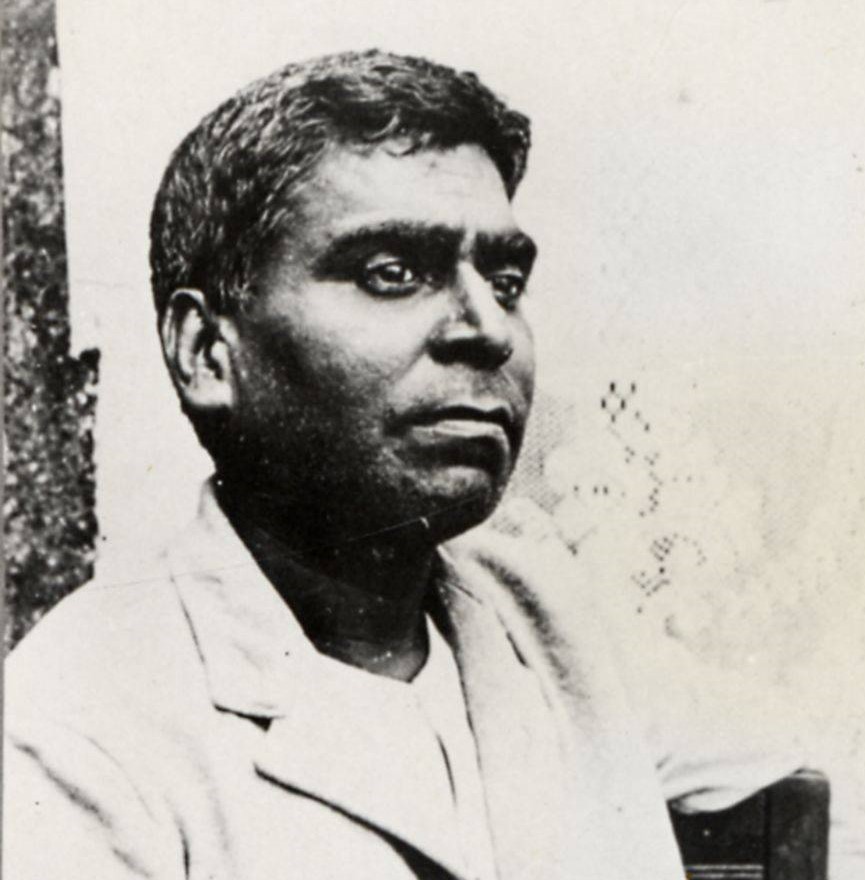
His sense of universal brotherhood made him the friend of all, and he was always eager for the benefit of all. Whoever contacted him was immeasurably benefited. The Thakur was never proud, and his amiable disposition was a characteristic feature of his life. He never uttered a word that would injure another’s feelings, and he never chastised anyone unless he was perfectly confident that he had the right to do so for that person’s welfare. On the other hand, whoever received a warning from him always felt himself purified by the experience. He did not possess the least shadow of vanity, although he was honored and respected throughout Bengal, Bihar and Orissa. His profound knowledge of philosophy endeared him to the educated, and his devout bhakti made him the friend of both the gentle and the ruffians.
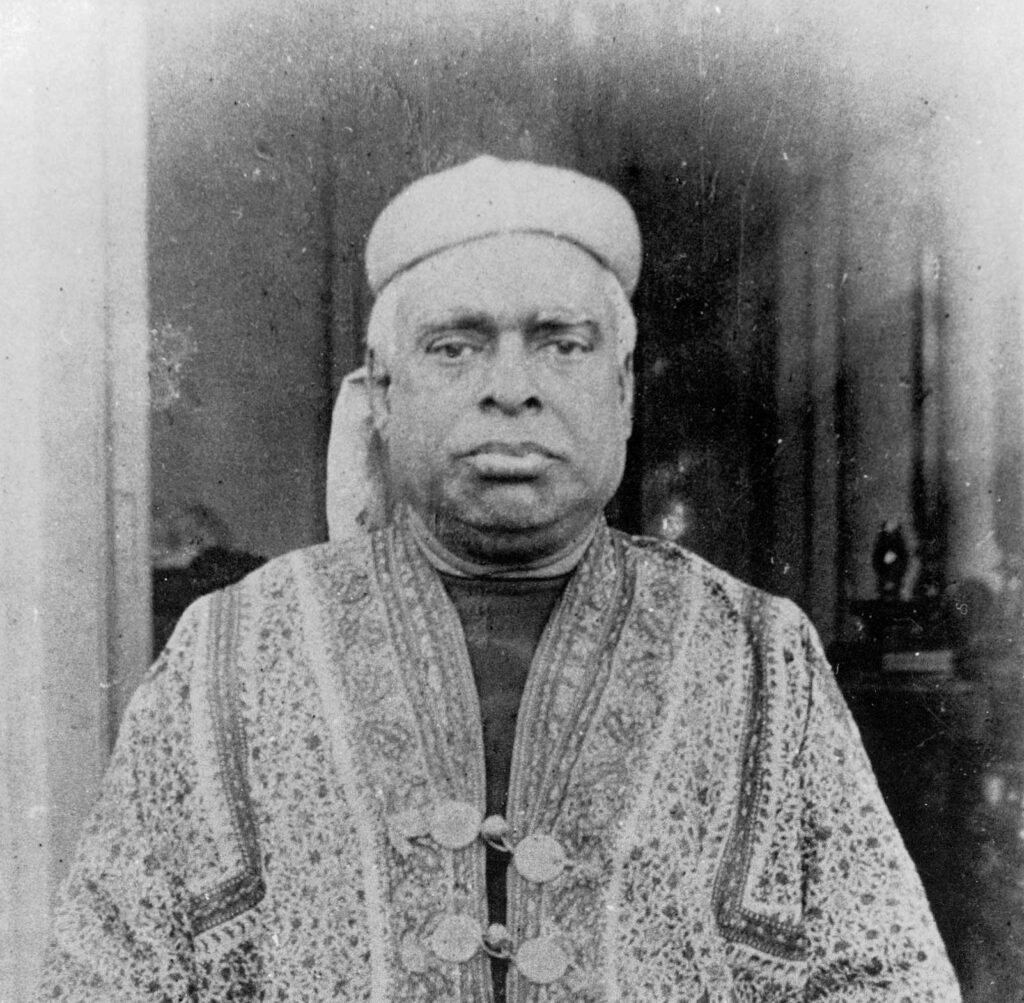
His Divine Grace A. C. Bhaktivedanta Swami Prabhupad highlighted the most wonderful contribution made by Srila Bhaktivinoda Thakur in a lecture given on Lord Chaitanya’s Appearance Day in 1969:
It was the desire of Bhaktivinoda Thakur to spread the life and precepts of Lord Chaitanya in the western countries. So with this in view – of publishing the book Sri Chaitanya Mahaprabhu: His Life and Precepts – he sent copies to various universities’ libraries, and one of the copies was found in the McGill University in Montreal. After seventy-two years, this book was found in the library by one of our students, and he brought it to me. …
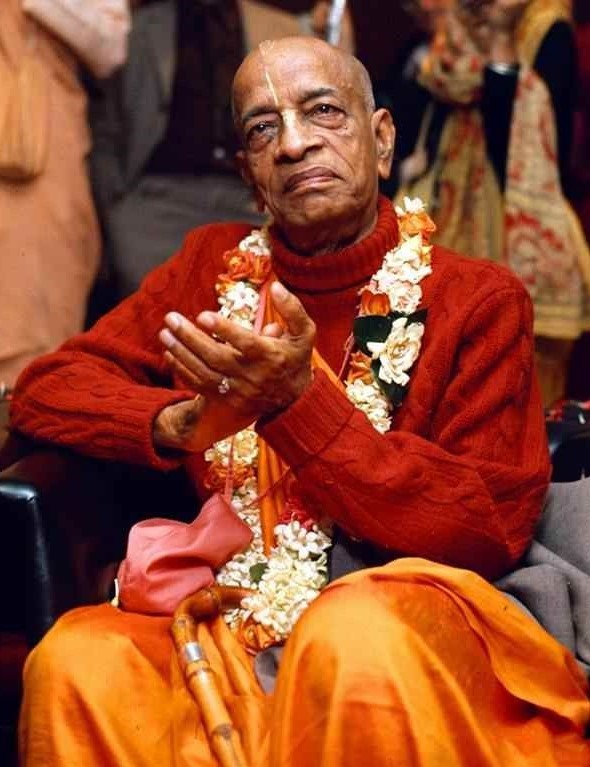
… We should take it for granted that whatever is happening at the present moment by my humble endeavor, it is all the grace of Bhaktivinoda Thakur. …Of course Lord Chaitanya inaugurated this Movement five hundred years ago, and after that, so many psuedo-Chaitanyites depreciated the whole thing. But the Chaitanya Movement in its pure form, as it is, was restarted by Bhaktivinoda Thakur … We should take it that Bhaktivinoda Thakur was the origin of the Krishna consciousness movement in its pure form.
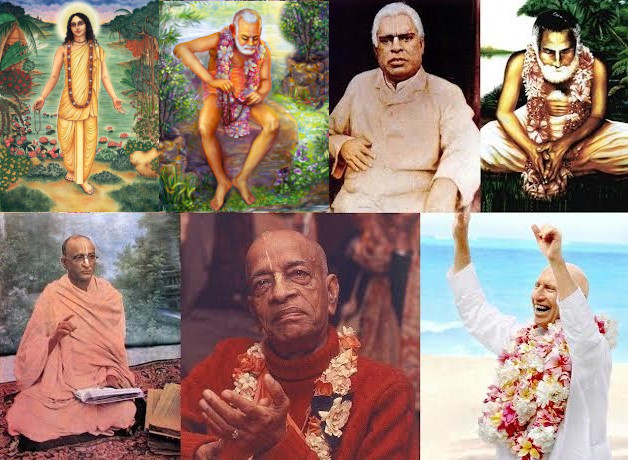
Bhaktivinoda wrote [almost] one hundred books … Just imagine – he was a very responsible officer, a magistrate, and he was grhastha; [he] also had many children. Altogether he had ten children, and he had to take care of children, the office of magistrate and extra religious work. He was made superintendent of the Temple of Jagannath, because the government knew that Bhaktivinoda Thakur was a very highly advanced religious person. Whenever there was some religious question, he was consulted.
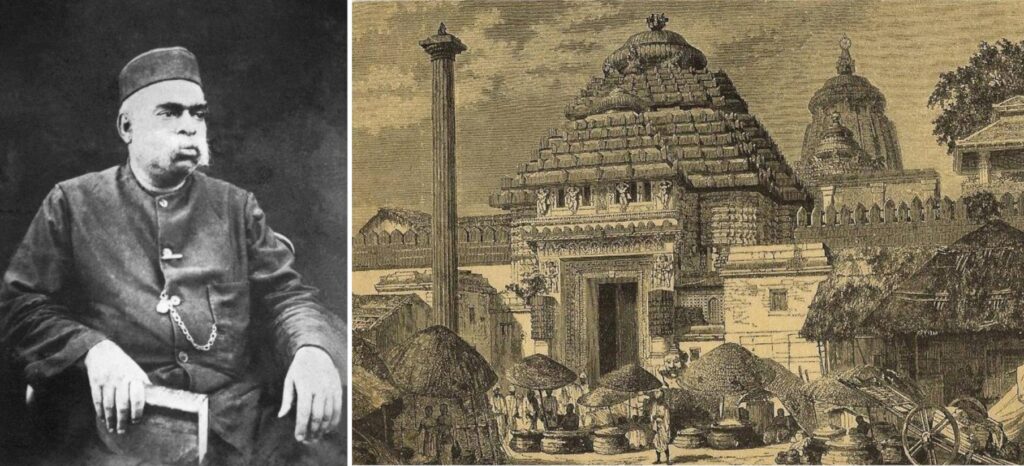
Jagannath Puri
In spite of all his responsibilities, as officer, or as family man with so many children, he executed his family life very nicely or else he could not have produced a child such as Bhaktisiddhanta Sarasvati Thakur. At the same time, he served the Supreme Lord in so many ways. That is the beauty. He has written so many books and in spite of cumbersome duties. That is the beauty of his life … he would come from the office in the evening and take his meals and go to bed. That was his program. And he’d sleep from eight to twelve at night, four hours, and then get up and write books until morning. That was his program.
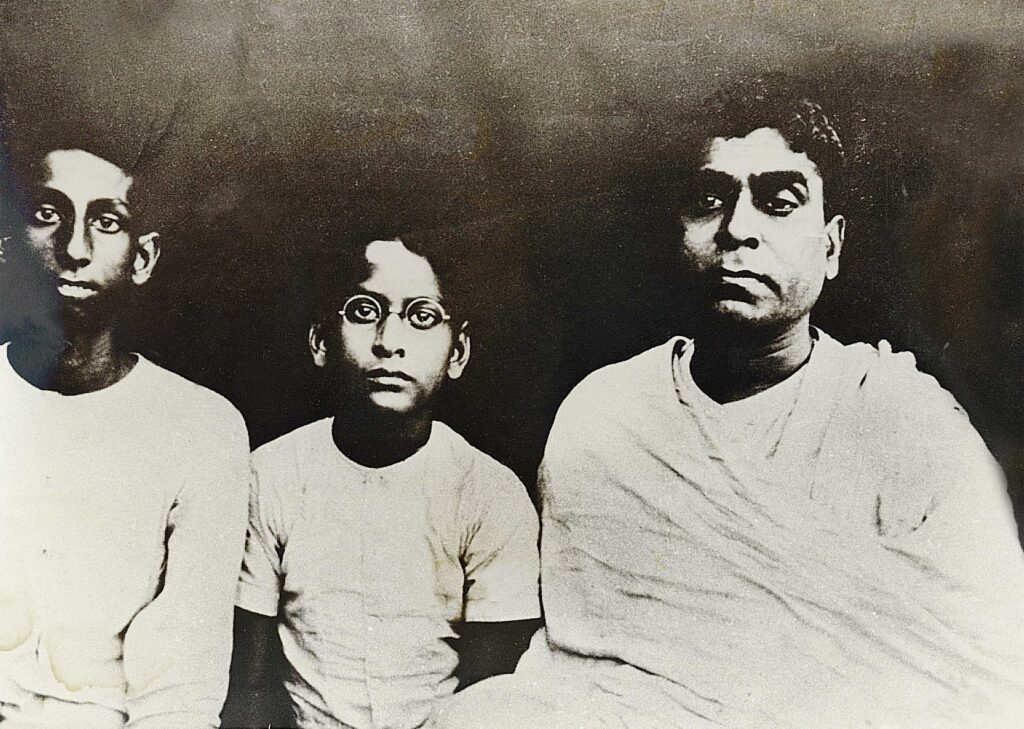
In this way, he wrote hundreds of books, some published, some in the course of [being] published. All this became possible because he was a sincere, faithful servant. To write so many books with so many responsibilities, for an ordinary magistrate is not possible. But because he was sincere, he got the strength from the Supreme Lord. One does not need to seek strength separate from the Supreme Lord. But if you are sincere the Supreme will give you sufficient strength.
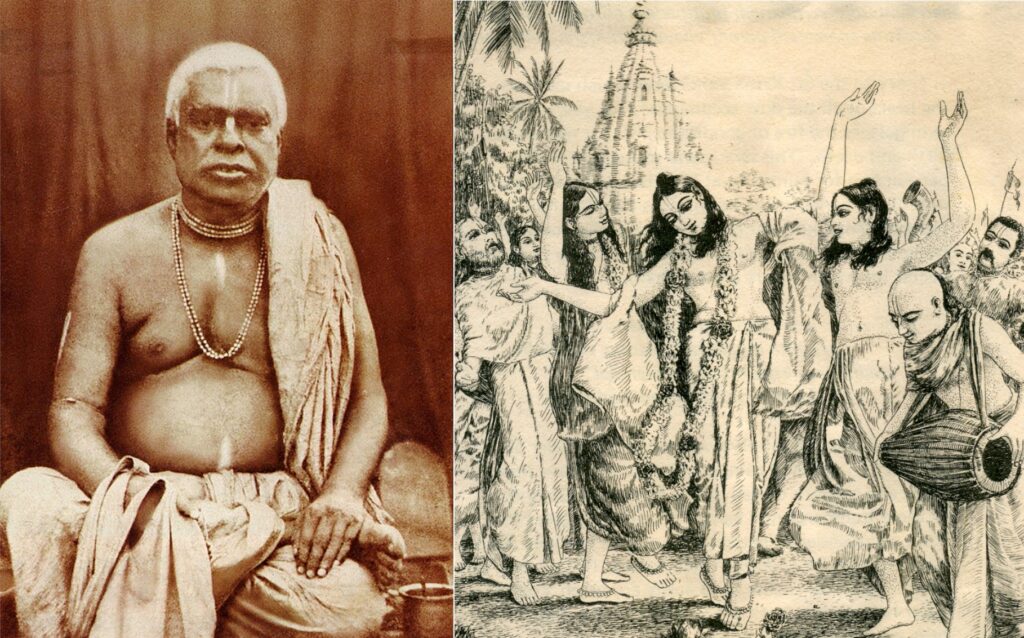
These wonderful words glorifying Srila Bhaktivinoda Thakur’s life by Srila Bhaktivedanta Swami establish a very important point: that the pure cult and teachings of Sri Chaitanya Mahaprabhu had been lost for all practical purposes, and that Srila Bhaktivinoda Thakur revitalised Lord Chaitanya’s movement almost single-handedly. Bhaktivinoda Thakur was certainly the pioneer who guided Lord Chaitanya’s sankirtan movement to leave the confines of India and spread throughout the world. And now we find Vaisnavas all over the world who are reaping the benefits of Srila Bhaktivinoda Thakur’s super-human efforts, abilities and determination to humbly serve Sri Guru and Sri Gauranga. The Thakur’s great stanza composed in glorification of Srila Haridas Thakur most certainly applies also to him:
He reasons ill who tells that Vaishnavs die
When thou art living still in sound.
The Vaishnavs die to live and living try
To spread a holy life around!
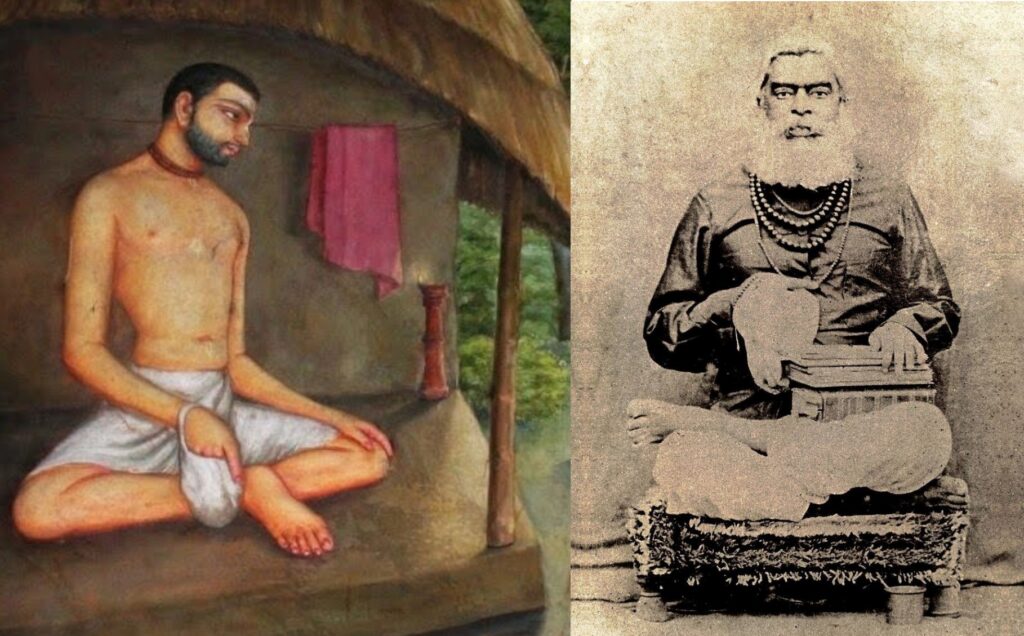

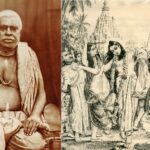
Comment
Many thanks for these extracts that allow a peak into the life and heart of an extraordinary predecessor Vaishnava saint!